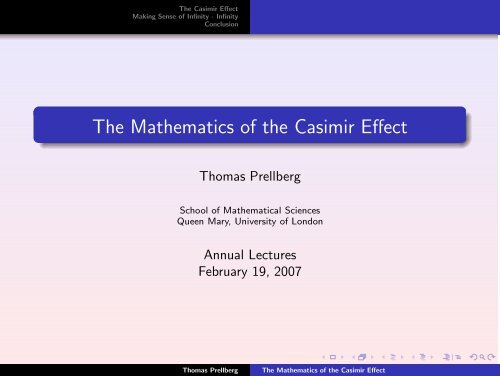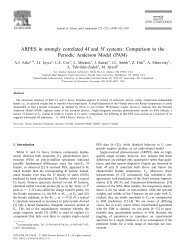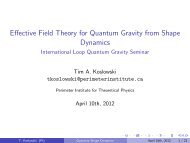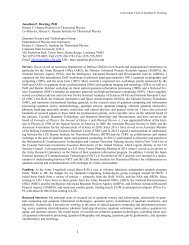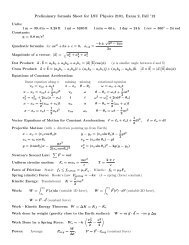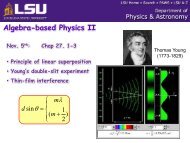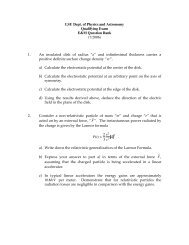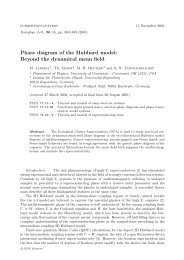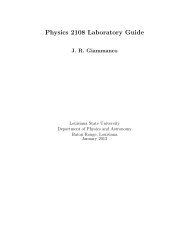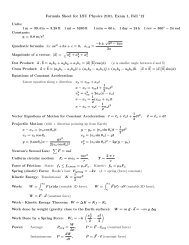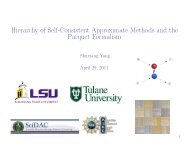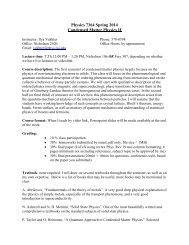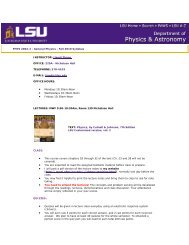The Mathematics of the Casimir Effect - School of Mathematical ...
The Mathematics of the Casimir Effect - School of Mathematical ...
The Mathematics of the Casimir Effect - School of Mathematical ...
Create successful ePaper yourself
Turn your PDF publications into a flip-book with our unique Google optimized e-Paper software.
<strong>The</strong> <strong>Casimir</strong> <strong>Effect</strong><br />
Making Sense <strong>of</strong> Infinity - Infinity<br />
Conclusion<br />
<strong>The</strong> <strong>Ma<strong>the</strong>matics</strong> <strong>of</strong> <strong>the</strong> <strong>Casimir</strong> <strong>Effect</strong><br />
Thomas Prellberg<br />
<strong>School</strong> <strong>of</strong> Ma<strong>the</strong>matical Sciences<br />
Queen Mary, University <strong>of</strong> London<br />
Annual Lectures<br />
February 19, 2007<br />
Thomas Prellberg<br />
<strong>The</strong> <strong>Ma<strong>the</strong>matics</strong> <strong>of</strong> <strong>the</strong> <strong>Casimir</strong> <strong>Effect</strong>
<strong>The</strong> <strong>Casimir</strong> <strong>Effect</strong><br />
Making Sense <strong>of</strong> Infinity - Infinity<br />
Conclusion<br />
<strong>Casimir</strong> forces: still surprising after<br />
60 years<br />
Physics Today, February 2007<br />
<strong>The</strong> <strong>Casimir</strong> effect heats up<br />
AIP News Update, February 7, 2007<br />
Scientists devise test for string<br />
<strong>the</strong>ory<br />
EE Times, February 6, 2007<br />
Thomas Prellberg<br />
<strong>The</strong> <strong>Ma<strong>the</strong>matics</strong> <strong>of</strong> <strong>the</strong> <strong>Casimir</strong> <strong>Effect</strong>
<strong>The</strong> <strong>Casimir</strong> <strong>Effect</strong><br />
Making Sense <strong>of</strong> Infinity - Infinity<br />
Conclusion<br />
<strong>Casimir</strong> forces: still surprising after<br />
60 years<br />
Physics Today, February 2007<br />
<strong>The</strong> <strong>Casimir</strong> effect heats up<br />
AIP News Update, February 7, 2007<br />
Scientists devise test for string<br />
<strong>the</strong>ory<br />
EE Times, February 6, 2007<br />
Thomas Prellberg<br />
<strong>The</strong> <strong>Ma<strong>the</strong>matics</strong> <strong>of</strong> <strong>the</strong> <strong>Casimir</strong> <strong>Effect</strong>
<strong>The</strong> <strong>Casimir</strong> <strong>Effect</strong><br />
Making Sense <strong>of</strong> Infinity - Infinity<br />
Conclusion<br />
<strong>Casimir</strong> forces: still surprising after<br />
60 years<br />
Physics Today, February 2007<br />
<strong>The</strong> <strong>Casimir</strong> effect heats up<br />
AIP News Update, February 7, 2007<br />
Scientists devise test for string<br />
<strong>the</strong>ory<br />
EE Times, February 6, 2007<br />
Thomas Prellberg<br />
<strong>The</strong> <strong>Ma<strong>the</strong>matics</strong> <strong>of</strong> <strong>the</strong> <strong>Casimir</strong> <strong>Effect</strong>
Topic Outline<br />
<strong>The</strong> <strong>Casimir</strong> <strong>Effect</strong><br />
Making Sense <strong>of</strong> Infinity - Infinity<br />
Conclusion<br />
1 <strong>The</strong> <strong>Casimir</strong> <strong>Effect</strong><br />
History<br />
Quantum Electrodynamics<br />
Zero-Point Energy Shift<br />
2 Making Sense <strong>of</strong> Infinity - Infinity<br />
<strong>The</strong> Ma<strong>the</strong>matical Setting<br />
Divergent Series<br />
Euler-Maclaurin Formula<br />
Abel-Plana Formula<br />
3 Conclusion<br />
Thomas Prellberg<br />
<strong>The</strong> <strong>Ma<strong>the</strong>matics</strong> <strong>of</strong> <strong>the</strong> <strong>Casimir</strong> <strong>Effect</strong>
Outline<br />
<strong>The</strong> <strong>Casimir</strong> <strong>Effect</strong><br />
Making Sense <strong>of</strong> Infinity - Infinity<br />
Conclusion<br />
History<br />
Quantum Electrodynamics<br />
Zero-Point Energy Shift<br />
1 <strong>The</strong> <strong>Casimir</strong> <strong>Effect</strong><br />
History<br />
Quantum Electrodynamics<br />
Zero-Point Energy Shift<br />
2 Making Sense <strong>of</strong> Infinity - Infinity<br />
3 Conclusion<br />
Thomas Prellberg<br />
<strong>The</strong> <strong>Ma<strong>the</strong>matics</strong> <strong>of</strong> <strong>the</strong> <strong>Casimir</strong> <strong>Effect</strong>
<strong>The</strong> <strong>Casimir</strong> <strong>Effect</strong><br />
Making Sense <strong>of</strong> Infinity - Infinity<br />
Conclusion<br />
History<br />
Quantum Electrodynamics<br />
Zero-Point Energy Shift<br />
student <strong>of</strong> Ehrenfest, worked with<br />
Pauli and Bohr<br />
retarded Van-der-Waals-forces<br />
E = 23<br />
4π c α R 7<br />
Force between cavity walls<br />
<strong>Casimir</strong> and Polder, 1948<br />
F = − π2 c<br />
240<br />
A<br />
d 4 <strong>Casimir</strong>, 1948<br />
Hendrik Brugt Gerhard<br />
<strong>Casimir</strong>, 1909 - 2000<br />
Thomas Prellberg<br />
<strong>The</strong> <strong>Ma<strong>the</strong>matics</strong> <strong>of</strong> <strong>the</strong> <strong>Casimir</strong> <strong>Effect</strong>
<strong>The</strong> <strong>Casimir</strong> <strong>Effect</strong><br />
Making Sense <strong>of</strong> Infinity - Infinity<br />
Conclusion<br />
History<br />
Quantum Electrodynamics<br />
Zero-Point Energy Shift<br />
student <strong>of</strong> Ehrenfest, worked with<br />
Pauli and Bohr<br />
retarded Van-der-Waals-forces<br />
E = 23<br />
4π c α R 7<br />
Force between cavity walls<br />
<strong>Casimir</strong> and Polder, 1948<br />
F = − π2 c<br />
240<br />
A<br />
d 4 <strong>Casimir</strong>, 1948<br />
Hendrik Brugt Gerhard<br />
<strong>Casimir</strong>, 1909 - 2000<br />
Thomas Prellberg<br />
<strong>The</strong> <strong>Ma<strong>the</strong>matics</strong> <strong>of</strong> <strong>the</strong> <strong>Casimir</strong> <strong>Effect</strong>
<strong>The</strong> <strong>Casimir</strong> <strong>Effect</strong><br />
Making Sense <strong>of</strong> Infinity - Infinity<br />
Conclusion<br />
History<br />
Quantum Electrodynamics<br />
Zero-Point Energy Shift<br />
student <strong>of</strong> Ehrenfest, worked with<br />
Pauli and Bohr<br />
retarded Van-der-Waals-forces<br />
E = 23<br />
4π c α R 7<br />
Force between cavity walls<br />
<strong>Casimir</strong> and Polder, 1948<br />
F = − π2 c<br />
240<br />
A<br />
d 4 <strong>Casimir</strong>, 1948<br />
Hendrik Brugt Gerhard<br />
<strong>Casimir</strong>, 1909 - 2000<br />
Thomas Prellberg<br />
<strong>The</strong> <strong>Ma<strong>the</strong>matics</strong> <strong>of</strong> <strong>the</strong> <strong>Casimir</strong> <strong>Effect</strong>
<strong>The</strong> <strong>Casimir</strong> <strong>Effect</strong><br />
Making Sense <strong>of</strong> Infinity - Infinity<br />
Conclusion<br />
<strong>The</strong> Electromagnetic Field<br />
History<br />
Quantum Electrodynamics<br />
Zero-Point Energy Shift<br />
<strong>The</strong> electromagnetic field, described by <strong>the</strong> Maxwell Equations,<br />
satisfies <strong>the</strong> wave equation<br />
(∆ − 1 ∂ 2 )<br />
⃗A(⃗x,<br />
c 2 ∂t 2 t) = 0<br />
Fourier-transformation (⃗x ↔ ⃗ k) gives<br />
( ) ∂<br />
2<br />
∂t 2 + ω2 ⃗A( ⃗ k, t) = 0 with ω = c| ⃗ k|<br />
which, for each ⃗ k, describes a harmonic oscillator<br />
Quantising harmonic oscillators is easy...<br />
Thomas Prellberg<br />
<strong>The</strong> <strong>Ma<strong>the</strong>matics</strong> <strong>of</strong> <strong>the</strong> <strong>Casimir</strong> <strong>Effect</strong>
<strong>The</strong> <strong>Casimir</strong> <strong>Effect</strong><br />
Making Sense <strong>of</strong> Infinity - Infinity<br />
Conclusion<br />
<strong>The</strong> Electromagnetic Field<br />
History<br />
Quantum Electrodynamics<br />
Zero-Point Energy Shift<br />
<strong>The</strong> electromagnetic field, described by <strong>the</strong> Maxwell Equations,<br />
satisfies <strong>the</strong> wave equation<br />
(∆ − 1 ∂ 2 )<br />
⃗A(⃗x,<br />
c 2 ∂t 2 t) = 0<br />
Fourier-transformation (⃗x ↔ ⃗ k) gives<br />
( ) ∂<br />
2<br />
∂t 2 + ω2 ⃗A( ⃗ k, t) = 0 with ω = c| ⃗ k|<br />
which, for each ⃗ k, describes a harmonic oscillator<br />
Quantising harmonic oscillators is easy...<br />
Thomas Prellberg<br />
<strong>The</strong> <strong>Ma<strong>the</strong>matics</strong> <strong>of</strong> <strong>the</strong> <strong>Casimir</strong> <strong>Effect</strong>
<strong>The</strong> <strong>Casimir</strong> <strong>Effect</strong><br />
Making Sense <strong>of</strong> Infinity - Infinity<br />
Conclusion<br />
<strong>The</strong> Electromagnetic Field<br />
History<br />
Quantum Electrodynamics<br />
Zero-Point Energy Shift<br />
<strong>The</strong> electromagnetic field, described by <strong>the</strong> Maxwell Equations,<br />
satisfies <strong>the</strong> wave equation<br />
(∆ − 1 ∂ 2 )<br />
⃗A(⃗x,<br />
c 2 ∂t 2 t) = 0<br />
Fourier-transformation (⃗x ↔ ⃗ k) gives<br />
( ) ∂<br />
2<br />
∂t 2 + ω2 ⃗A( ⃗ k, t) = 0 with ω = c| ⃗ k|<br />
which, for each ⃗ k, describes a harmonic oscillator<br />
Quantising harmonic oscillators is easy...<br />
Thomas Prellberg<br />
<strong>The</strong> <strong>Ma<strong>the</strong>matics</strong> <strong>of</strong> <strong>the</strong> <strong>Casimir</strong> <strong>Effect</strong>
<strong>The</strong> <strong>Casimir</strong> <strong>Effect</strong><br />
Making Sense <strong>of</strong> Infinity - Infinity<br />
Conclusion<br />
Quantisation <strong>of</strong> <strong>the</strong> Field<br />
History<br />
Quantum Electrodynamics<br />
Zero-Point Energy Shift<br />
Each harmonic oscillator can be in a discrete state <strong>of</strong> energy<br />
(<br />
E m ( ⃗ k) = m + 1 )<br />
ω with ω = c|<br />
2<br />
⃗ k|<br />
Interpretation: m photons with energy ω and momentum ⃗ k<br />
In particular, <strong>the</strong> ground state energy 1 2ω is non-zero!<br />
This leads to a zero-point energy density <strong>of</strong> <strong>the</strong> field<br />
∫<br />
E<br />
V = 2<br />
E 0 ( ⃗ k) d 3 k<br />
(2π) 3<br />
(factor 2 due to polarisation <strong>of</strong> <strong>the</strong> field)<br />
Caveat: this quantity is infinite...<br />
Thomas Prellberg<br />
<strong>The</strong> <strong>Ma<strong>the</strong>matics</strong> <strong>of</strong> <strong>the</strong> <strong>Casimir</strong> <strong>Effect</strong>
<strong>The</strong> <strong>Casimir</strong> <strong>Effect</strong><br />
Making Sense <strong>of</strong> Infinity - Infinity<br />
Conclusion<br />
Quantisation <strong>of</strong> <strong>the</strong> Field<br />
History<br />
Quantum Electrodynamics<br />
Zero-Point Energy Shift<br />
Each harmonic oscillator can be in a discrete state <strong>of</strong> energy<br />
(<br />
E m ( ⃗ k) = m + 1 )<br />
ω with ω = c|<br />
2<br />
⃗ k|<br />
Interpretation: m photons with energy ω and momentum ⃗ k<br />
In particular, <strong>the</strong> ground state energy 1 2ω is non-zero!<br />
This leads to a zero-point energy density <strong>of</strong> <strong>the</strong> field<br />
∫<br />
E<br />
V = 2<br />
E 0 ( ⃗ k) d 3 k<br />
(2π) 3<br />
(factor 2 due to polarisation <strong>of</strong> <strong>the</strong> field)<br />
Caveat: this quantity is infinite...<br />
Thomas Prellberg<br />
<strong>The</strong> <strong>Ma<strong>the</strong>matics</strong> <strong>of</strong> <strong>the</strong> <strong>Casimir</strong> <strong>Effect</strong>
<strong>The</strong> <strong>Casimir</strong> <strong>Effect</strong><br />
Making Sense <strong>of</strong> Infinity - Infinity<br />
Conclusion<br />
Quantisation <strong>of</strong> <strong>the</strong> Field<br />
History<br />
Quantum Electrodynamics<br />
Zero-Point Energy Shift<br />
Each harmonic oscillator can be in a discrete state <strong>of</strong> energy<br />
(<br />
E m ( ⃗ k) = m + 1 )<br />
ω with ω = c|<br />
2<br />
⃗ k|<br />
Interpretation: m photons with energy ω and momentum ⃗ k<br />
In particular, <strong>the</strong> ground state energy 1 2ω is non-zero!<br />
This leads to a zero-point energy density <strong>of</strong> <strong>the</strong> field<br />
∫<br />
E<br />
V = 2<br />
E 0 ( ⃗ k) d 3 k<br />
(2π) 3<br />
(factor 2 due to polarisation <strong>of</strong> <strong>the</strong> field)<br />
Caveat: this quantity is infinite...<br />
Thomas Prellberg<br />
<strong>The</strong> <strong>Ma<strong>the</strong>matics</strong> <strong>of</strong> <strong>the</strong> <strong>Casimir</strong> <strong>Effect</strong>
<strong>The</strong> <strong>Casimir</strong> <strong>Effect</strong><br />
Making Sense <strong>of</strong> Infinity - Infinity<br />
Conclusion<br />
Quantisation <strong>of</strong> <strong>the</strong> Field<br />
History<br />
Quantum Electrodynamics<br />
Zero-Point Energy Shift<br />
Each harmonic oscillator can be in a discrete state <strong>of</strong> energy<br />
(<br />
E m ( ⃗ k) = m + 1 )<br />
ω with ω = c|<br />
2<br />
⃗ k|<br />
Interpretation: m photons with energy ω and momentum ⃗ k<br />
In particular, <strong>the</strong> ground state energy 1 2ω is non-zero!<br />
This leads to a zero-point energy density <strong>of</strong> <strong>the</strong> field<br />
∫<br />
E<br />
V = 2<br />
E 0 ( ⃗ k) d 3 k<br />
(2π) 3<br />
(factor 2 due to polarisation <strong>of</strong> <strong>the</strong> field)<br />
Caveat: this quantity is infinite...<br />
Thomas Prellberg<br />
<strong>The</strong> <strong>Ma<strong>the</strong>matics</strong> <strong>of</strong> <strong>the</strong> <strong>Casimir</strong> <strong>Effect</strong>
<strong>The</strong> <strong>Casimir</strong> <strong>Effect</strong><br />
Making Sense <strong>of</strong> Infinity - Infinity<br />
Conclusion<br />
Quantisation <strong>of</strong> <strong>the</strong> Field<br />
History<br />
Quantum Electrodynamics<br />
Zero-Point Energy Shift<br />
Each harmonic oscillator can be in a discrete state <strong>of</strong> energy<br />
(<br />
E m ( ⃗ k) = m + 1 )<br />
ω with ω = c|<br />
2<br />
⃗ k|<br />
Interpretation: m photons with energy ω and momentum ⃗ k<br />
In particular, <strong>the</strong> ground state energy 1 2ω is non-zero!<br />
This leads to a zero-point energy density <strong>of</strong> <strong>the</strong> field<br />
∫<br />
E<br />
V = 2<br />
E 0 ( ⃗ k) d 3 k<br />
(2π) 3<br />
(factor 2 due to polarisation <strong>of</strong> <strong>the</strong> field)<br />
Caveat: this quantity is infinite...<br />
Thomas Prellberg<br />
<strong>The</strong> <strong>Ma<strong>the</strong>matics</strong> <strong>of</strong> <strong>the</strong> <strong>Casimir</strong> <strong>Effect</strong>
<strong>The</strong> <strong>Casimir</strong> <strong>Effect</strong><br />
Making Sense <strong>of</strong> Infinity - Infinity<br />
Conclusion<br />
Making (Physical) Sense <strong>of</strong> Infinity<br />
History<br />
Quantum Electrodynamics<br />
Zero-Point Energy Shift<br />
<strong>The</strong> zero-point energy shifts due to a restricted geometry<br />
In <strong>the</strong> presence <strong>of</strong> <strong>the</strong> boundary<br />
E discrete = ∑ n<br />
E 0,n<br />
is a sum over discrete energies E 0,n = 1 2 ω n<br />
In <strong>the</strong> absence <strong>of</strong> a boundary<br />
∫<br />
E = 2V<br />
<strong>The</strong> difference <strong>of</strong> <strong>the</strong> infinite zero-point energies is finite!<br />
∆E = E discrete − E = − π2 c L 2<br />
720 d 3<br />
for a box <strong>of</strong> size L × L × d with d ≪ L<br />
E 0 ( ⃗ k) d 3 k<br />
(2π) 3<br />
Thomas Prellberg<br />
<strong>The</strong> <strong>Ma<strong>the</strong>matics</strong> <strong>of</strong> <strong>the</strong> <strong>Casimir</strong> <strong>Effect</strong>
<strong>The</strong> <strong>Casimir</strong> <strong>Effect</strong><br />
Making Sense <strong>of</strong> Infinity - Infinity<br />
Conclusion<br />
Making (Physical) Sense <strong>of</strong> Infinity<br />
History<br />
Quantum Electrodynamics<br />
Zero-Point Energy Shift<br />
<strong>The</strong> zero-point energy shifts due to a restricted geometry<br />
In <strong>the</strong> presence <strong>of</strong> <strong>the</strong> boundary<br />
E discrete = ∑ n<br />
E 0,n<br />
is a sum over discrete energies E 0,n = 1 2 ω n<br />
In <strong>the</strong> absence <strong>of</strong> a boundary<br />
∫<br />
E = 2V<br />
<strong>The</strong> difference <strong>of</strong> <strong>the</strong> infinite zero-point energies is finite!<br />
∆E = E discrete − E = − π2 c L 2<br />
720 d 3<br />
for a box <strong>of</strong> size L × L × d with d ≪ L<br />
E 0 ( ⃗ k) d 3 k<br />
(2π) 3<br />
Thomas Prellberg<br />
<strong>The</strong> <strong>Ma<strong>the</strong>matics</strong> <strong>of</strong> <strong>the</strong> <strong>Casimir</strong> <strong>Effect</strong>
<strong>The</strong> <strong>Casimir</strong> <strong>Effect</strong><br />
Making Sense <strong>of</strong> Infinity - Infinity<br />
Conclusion<br />
Making (Physical) Sense <strong>of</strong> Infinity<br />
History<br />
Quantum Electrodynamics<br />
Zero-Point Energy Shift<br />
<strong>The</strong> zero-point energy shifts due to a restricted geometry<br />
In <strong>the</strong> presence <strong>of</strong> <strong>the</strong> boundary<br />
E discrete = ∑ n<br />
E 0,n<br />
is a sum over discrete energies E 0,n = 1 2 ω n<br />
In <strong>the</strong> absence <strong>of</strong> a boundary<br />
∫<br />
E = 2V<br />
<strong>The</strong> difference <strong>of</strong> <strong>the</strong> infinite zero-point energies is finite!<br />
∆E = E discrete − E = − π2 c L 2<br />
720 d 3<br />
for a box <strong>of</strong> size L × L × d with d ≪ L<br />
E 0 ( ⃗ k) d 3 k<br />
(2π) 3<br />
Thomas Prellberg<br />
<strong>The</strong> <strong>Ma<strong>the</strong>matics</strong> <strong>of</strong> <strong>the</strong> <strong>Casimir</strong> <strong>Effect</strong>
<strong>The</strong> <strong>Casimir</strong> <strong>Effect</strong><br />
Making Sense <strong>of</strong> Infinity - Infinity<br />
Conclusion<br />
Making (Physical) Sense <strong>of</strong> Infinity<br />
History<br />
Quantum Electrodynamics<br />
Zero-Point Energy Shift<br />
<strong>The</strong> zero-point energy shifts due to a restricted geometry<br />
In <strong>the</strong> presence <strong>of</strong> <strong>the</strong> boundary<br />
E discrete = ∑ n<br />
E 0,n<br />
is a sum over discrete energies E 0,n = 1 2 ω n<br />
In <strong>the</strong> absence <strong>of</strong> a boundary<br />
∫<br />
E = 2V<br />
<strong>The</strong> difference <strong>of</strong> <strong>the</strong> infinite zero-point energies is finite!<br />
∆E = E discrete − E = − π2 c L 2<br />
720 d 3<br />
for a box <strong>of</strong> size L × L × d with d ≪ L<br />
E 0 ( ⃗ k) d 3 k<br />
(2π) 3<br />
Thomas Prellberg<br />
<strong>The</strong> <strong>Ma<strong>the</strong>matics</strong> <strong>of</strong> <strong>the</strong> <strong>Casimir</strong> <strong>Effect</strong>
<strong>The</strong> <strong>Casimir</strong> <strong>Effect</strong><br />
Making Sense <strong>of</strong> Infinity - Infinity<br />
Conclusion<br />
History<br />
Quantum Electrodynamics<br />
Zero-Point Energy Shift<br />
Wolfgang Pauli’s initial reaction: ‘absolute nonsense’<br />
Experimental verification<br />
Sparnaay (1958): ‘not inconsistent with’<br />
van Blokland and Overbeek (1978): experimental accuracy <strong>of</strong> 50%<br />
Lamoreaux (1997): experimental accuracy <strong>of</strong> 5%<br />
<strong>The</strong>oretical extensions<br />
Geometry dependence<br />
Dynamical <strong>Casimir</strong> effect<br />
Real media: non-zero temperature, finite conductivity, roughness, . . .<br />
We are done with <strong>the</strong> physics. Let’s look at some ma<strong>the</strong>matics!<br />
Thomas Prellberg<br />
<strong>The</strong> <strong>Ma<strong>the</strong>matics</strong> <strong>of</strong> <strong>the</strong> <strong>Casimir</strong> <strong>Effect</strong>
<strong>The</strong> <strong>Casimir</strong> <strong>Effect</strong><br />
Making Sense <strong>of</strong> Infinity - Infinity<br />
Conclusion<br />
History<br />
Quantum Electrodynamics<br />
Zero-Point Energy Shift<br />
Wolfgang Pauli’s initial reaction: ‘absolute nonsense’<br />
Experimental verification<br />
Sparnaay (1958): ‘not inconsistent with’<br />
van Blokland and Overbeek (1978): experimental accuracy <strong>of</strong> 50%<br />
Lamoreaux (1997): experimental accuracy <strong>of</strong> 5%<br />
<strong>The</strong>oretical extensions<br />
Geometry dependence<br />
Dynamical <strong>Casimir</strong> effect<br />
Real media: non-zero temperature, finite conductivity, roughness, . . .<br />
We are done with <strong>the</strong> physics. Let’s look at some ma<strong>the</strong>matics!<br />
Thomas Prellberg<br />
<strong>The</strong> <strong>Ma<strong>the</strong>matics</strong> <strong>of</strong> <strong>the</strong> <strong>Casimir</strong> <strong>Effect</strong>
<strong>The</strong> <strong>Casimir</strong> <strong>Effect</strong><br />
Making Sense <strong>of</strong> Infinity - Infinity<br />
Conclusion<br />
History<br />
Quantum Electrodynamics<br />
Zero-Point Energy Shift<br />
Wolfgang Pauli’s initial reaction: ‘absolute nonsense’<br />
Experimental verification<br />
Sparnaay (1958): ‘not inconsistent with’<br />
van Blokland and Overbeek (1978): experimental accuracy <strong>of</strong> 50%<br />
Lamoreaux (1997): experimental accuracy <strong>of</strong> 5%<br />
<strong>The</strong>oretical extensions<br />
Geometry dependence<br />
Dynamical <strong>Casimir</strong> effect<br />
Real media: non-zero temperature, finite conductivity, roughness, . . .<br />
We are done with <strong>the</strong> physics. Let’s look at some ma<strong>the</strong>matics!<br />
Thomas Prellberg<br />
<strong>The</strong> <strong>Ma<strong>the</strong>matics</strong> <strong>of</strong> <strong>the</strong> <strong>Casimir</strong> <strong>Effect</strong>
<strong>The</strong> <strong>Casimir</strong> <strong>Effect</strong><br />
Making Sense <strong>of</strong> Infinity - Infinity<br />
Conclusion<br />
History<br />
Quantum Electrodynamics<br />
Zero-Point Energy Shift<br />
Wolfgang Pauli’s initial reaction: ‘absolute nonsense’<br />
Experimental verification<br />
Sparnaay (1958): ‘not inconsistent with’<br />
van Blokland and Overbeek (1978): experimental accuracy <strong>of</strong> 50%<br />
Lamoreaux (1997): experimental accuracy <strong>of</strong> 5%<br />
<strong>The</strong>oretical extensions<br />
Geometry dependence<br />
Dynamical <strong>Casimir</strong> effect<br />
Real media: non-zero temperature, finite conductivity, roughness, . . .<br />
We are done with <strong>the</strong> physics. Let’s look at some ma<strong>the</strong>matics!<br />
Thomas Prellberg<br />
<strong>The</strong> <strong>Ma<strong>the</strong>matics</strong> <strong>of</strong> <strong>the</strong> <strong>Casimir</strong> <strong>Effect</strong>
Outline<br />
<strong>The</strong> <strong>Casimir</strong> <strong>Effect</strong><br />
Making Sense <strong>of</strong> Infinity - Infinity<br />
Conclusion<br />
<strong>The</strong> Ma<strong>the</strong>matical Setting<br />
Divergent Series<br />
Euler-Maclaurin Formula<br />
Abel-Plana Formula<br />
1 <strong>The</strong> <strong>Casimir</strong> <strong>Effect</strong><br />
2 Making Sense <strong>of</strong> Infinity - Infinity<br />
<strong>The</strong> Ma<strong>the</strong>matical Setting<br />
Divergent Series<br />
Euler-Maclaurin Formula<br />
Abel-Plana Formula<br />
3 Conclusion<br />
Thomas Prellberg<br />
<strong>The</strong> <strong>Ma<strong>the</strong>matics</strong> <strong>of</strong> <strong>the</strong> <strong>Casimir</strong> <strong>Effect</strong>
Spectral <strong>The</strong>ory<br />
<strong>The</strong> <strong>Casimir</strong> <strong>Effect</strong><br />
Making Sense <strong>of</strong> Infinity - Infinity<br />
Conclusion<br />
<strong>The</strong> Ma<strong>the</strong>matical Setting<br />
Divergent Series<br />
Euler-Maclaurin Formula<br />
Abel-Plana Formula<br />
Consider −∆ for a compact manifold Ω with a smooth boundary ∂Ω<br />
On a suitable function space, this operator is self-adjoint and<br />
positive with pure point spectrum<br />
One finds formally<br />
E discrete = 1 c Trace(−∆)1/2<br />
2<br />
This would be a different talk — let’s keep it simple for today<br />
Choose<br />
Ω = [0, L] and ∆ = ∂2<br />
∂x 2<br />
with Dirichlet boundary conditions f (0) = f (L) = 0.<br />
Thomas Prellberg<br />
<strong>The</strong> <strong>Ma<strong>the</strong>matics</strong> <strong>of</strong> <strong>the</strong> <strong>Casimir</strong> <strong>Effect</strong>
Spectral <strong>The</strong>ory<br />
<strong>The</strong> <strong>Casimir</strong> <strong>Effect</strong><br />
Making Sense <strong>of</strong> Infinity - Infinity<br />
Conclusion<br />
<strong>The</strong> Ma<strong>the</strong>matical Setting<br />
Divergent Series<br />
Euler-Maclaurin Formula<br />
Abel-Plana Formula<br />
Consider −∆ for a compact manifold Ω with a smooth boundary ∂Ω<br />
On a suitable function space, this operator is self-adjoint and<br />
positive with pure point spectrum<br />
One finds formally<br />
E discrete = 1 c Trace(−∆)1/2<br />
2<br />
This would be a different talk — let’s keep it simple for today<br />
Choose<br />
Ω = [0, L] and ∆ = ∂2<br />
∂x 2<br />
with Dirichlet boundary conditions f (0) = f (L) = 0.<br />
Thomas Prellberg<br />
<strong>The</strong> <strong>Ma<strong>the</strong>matics</strong> <strong>of</strong> <strong>the</strong> <strong>Casimir</strong> <strong>Effect</strong>
Spectral <strong>The</strong>ory<br />
<strong>The</strong> <strong>Casimir</strong> <strong>Effect</strong><br />
Making Sense <strong>of</strong> Infinity - Infinity<br />
Conclusion<br />
<strong>The</strong> Ma<strong>the</strong>matical Setting<br />
Divergent Series<br />
Euler-Maclaurin Formula<br />
Abel-Plana Formula<br />
Consider −∆ for a compact manifold Ω with a smooth boundary ∂Ω<br />
On a suitable function space, this operator is self-adjoint and<br />
positive with pure point spectrum<br />
One finds formally<br />
E discrete = 1 c Trace(−∆)1/2<br />
2<br />
This would be a different talk — let’s keep it simple for today<br />
Choose<br />
Ω = [0, L] and ∆ = ∂2<br />
∂x 2<br />
with Dirichlet boundary conditions f (0) = f (L) = 0.<br />
Thomas Prellberg<br />
<strong>The</strong> <strong>Ma<strong>the</strong>matics</strong> <strong>of</strong> <strong>the</strong> <strong>Casimir</strong> <strong>Effect</strong>
Spectral <strong>The</strong>ory<br />
<strong>The</strong> <strong>Casimir</strong> <strong>Effect</strong><br />
Making Sense <strong>of</strong> Infinity - Infinity<br />
Conclusion<br />
<strong>The</strong> Ma<strong>the</strong>matical Setting<br />
Divergent Series<br />
Euler-Maclaurin Formula<br />
Abel-Plana Formula<br />
Consider −∆ for a compact manifold Ω with a smooth boundary ∂Ω<br />
On a suitable function space, this operator is self-adjoint and<br />
positive with pure point spectrum<br />
One finds formally<br />
E discrete = 1 c Trace(−∆)1/2<br />
2<br />
This would be a different talk — let’s keep it simple for today<br />
Choose<br />
Ω = [0, L] and ∆ = ∂2<br />
∂x 2<br />
with Dirichlet boundary conditions f (0) = f (L) = 0.<br />
Thomas Prellberg<br />
<strong>The</strong> <strong>Ma<strong>the</strong>matics</strong> <strong>of</strong> <strong>the</strong> <strong>Casimir</strong> <strong>Effect</strong>
Spectral <strong>The</strong>ory<br />
<strong>The</strong> <strong>Casimir</strong> <strong>Effect</strong><br />
Making Sense <strong>of</strong> Infinity - Infinity<br />
Conclusion<br />
<strong>The</strong> Ma<strong>the</strong>matical Setting<br />
Divergent Series<br />
Euler-Maclaurin Formula<br />
Abel-Plana Formula<br />
Consider −∆ for a compact manifold Ω with a smooth boundary ∂Ω<br />
On a suitable function space, this operator is self-adjoint and<br />
positive with pure point spectrum<br />
One finds formally<br />
E discrete = 1 c Trace(−∆)1/2<br />
2<br />
This would be a different talk — let’s keep it simple for today<br />
Choose<br />
Ω = [0, L] and ∆ = ∂2<br />
∂x 2<br />
with Dirichlet boundary conditions f (0) = f (L) = 0.<br />
Thomas Prellberg<br />
<strong>The</strong> <strong>Ma<strong>the</strong>matics</strong> <strong>of</strong> <strong>the</strong> <strong>Casimir</strong> <strong>Effect</strong>
Spectral <strong>The</strong>ory<br />
<strong>The</strong> <strong>Casimir</strong> <strong>Effect</strong><br />
Making Sense <strong>of</strong> Infinity - Infinity<br />
Conclusion<br />
<strong>The</strong> Ma<strong>the</strong>matical Setting<br />
Divergent Series<br />
Euler-Maclaurin Formula<br />
Abel-Plana Formula<br />
Consider −∆ for a compact manifold Ω with a smooth boundary ∂Ω<br />
On a suitable function space, this operator is self-adjoint and<br />
positive with pure point spectrum<br />
One finds formally<br />
E discrete = 1 c Trace(−∆)1/2<br />
2<br />
This would be a different talk — let’s keep it simple for today<br />
Choose<br />
Ω = [0, L] and ∆ = ∂2<br />
∂x 2<br />
with Dirichlet boundary conditions f (0) = f (L) = 0.<br />
Thomas Prellberg<br />
<strong>The</strong> <strong>Ma<strong>the</strong>matics</strong> <strong>of</strong> <strong>the</strong> <strong>Casimir</strong> <strong>Effect</strong>
<strong>The</strong> <strong>Casimir</strong> <strong>Effect</strong><br />
Making Sense <strong>of</strong> Infinity - Infinity<br />
Conclusion<br />
<strong>Casimir</strong> <strong>Effect</strong> in One Dimension<br />
<strong>The</strong> Ma<strong>the</strong>matical Setting<br />
Divergent Series<br />
Euler-Maclaurin Formula<br />
Abel-Plana Formula<br />
<strong>The</strong> solutions are standing waves with wavelength λ satisfying<br />
We <strong>the</strong>refore find<br />
n λ 2 = L<br />
E 0,n = 1 2 c nπ L<br />
<strong>The</strong> zero-point energies are given by<br />
E discrete = π ∞ 2L c ∑<br />
n and E = π ∫ ∞<br />
2L c t dt<br />
n=0<br />
0<br />
Thomas Prellberg<br />
<strong>The</strong> <strong>Ma<strong>the</strong>matics</strong> <strong>of</strong> <strong>the</strong> <strong>Casimir</strong> <strong>Effect</strong>
<strong>The</strong> <strong>Casimir</strong> <strong>Effect</strong><br />
Making Sense <strong>of</strong> Infinity - Infinity<br />
Conclusion<br />
<strong>Casimir</strong> <strong>Effect</strong> in One Dimension<br />
<strong>The</strong> Ma<strong>the</strong>matical Setting<br />
Divergent Series<br />
Euler-Maclaurin Formula<br />
Abel-Plana Formula<br />
<strong>The</strong> solutions are standing waves with wavelength λ satisfying<br />
We <strong>the</strong>refore find<br />
n λ 2 = L<br />
E 0,n = 1 2 c nπ L<br />
<strong>The</strong> zero-point energies are given by<br />
E discrete = π ∞ 2L c ∑<br />
n and E = π ∫ ∞<br />
2L c t dt<br />
n=0<br />
0<br />
Thomas Prellberg<br />
<strong>The</strong> <strong>Ma<strong>the</strong>matics</strong> <strong>of</strong> <strong>the</strong> <strong>Casimir</strong> <strong>Effect</strong>
<strong>The</strong> <strong>Casimir</strong> <strong>Effect</strong><br />
Making Sense <strong>of</strong> Infinity - Infinity<br />
Conclusion<br />
<strong>Casimir</strong> <strong>Effect</strong> in One Dimension<br />
<strong>The</strong> Ma<strong>the</strong>matical Setting<br />
Divergent Series<br />
Euler-Maclaurin Formula<br />
Abel-Plana Formula<br />
<strong>The</strong> solutions are standing waves with wavelength λ satisfying<br />
We <strong>the</strong>refore find<br />
n λ 2 = L<br />
E 0,n = 1 2 c nπ L<br />
<strong>The</strong> zero-point energies are given by<br />
E discrete = π ∞ 2L c ∑<br />
n and E = π ∫ ∞<br />
2L c t dt<br />
n=0<br />
0<br />
Thomas Prellberg<br />
<strong>The</strong> <strong>Ma<strong>the</strong>matics</strong> <strong>of</strong> <strong>the</strong> <strong>Casimir</strong> <strong>Effect</strong>
<strong>The</strong> <strong>Casimir</strong> <strong>Effect</strong><br />
Making Sense <strong>of</strong> Infinity - Infinity<br />
Conclusion<br />
<strong>The</strong> Ma<strong>the</strong>matical Problem<br />
<strong>The</strong> Ma<strong>the</strong>matical Setting<br />
Divergent Series<br />
Euler-Maclaurin Formula<br />
Abel-Plana Formula<br />
We need to make sense <strong>of</strong><br />
(<br />
∆E = E discrete − E = π ∞<br />
2L c ∑<br />
n −<br />
∫ ∞<br />
n=0 0<br />
t dt<br />
)<br />
More generally, consider<br />
∞∑<br />
∆(f ) = f (n) −<br />
∫ ∞<br />
n=0<br />
0<br />
f (t) dt<br />
Thomas Prellberg<br />
<strong>The</strong> <strong>Ma<strong>the</strong>matics</strong> <strong>of</strong> <strong>the</strong> <strong>Casimir</strong> <strong>Effect</strong>
<strong>The</strong> <strong>Casimir</strong> <strong>Effect</strong><br />
Making Sense <strong>of</strong> Infinity - Infinity<br />
Conclusion<br />
<strong>The</strong> Ma<strong>the</strong>matical Problem<br />
<strong>The</strong> Ma<strong>the</strong>matical Setting<br />
Divergent Series<br />
Euler-Maclaurin Formula<br />
Abel-Plana Formula<br />
We need to make sense <strong>of</strong><br />
(<br />
∆E = E discrete − E = π ∞<br />
2L c ∑<br />
n −<br />
∫ ∞<br />
n=0 0<br />
t dt<br />
)<br />
More generally, consider<br />
∞∑<br />
∆(f ) = f (n) −<br />
∫ ∞<br />
n=0<br />
0<br />
f (t) dt<br />
Thomas Prellberg<br />
<strong>The</strong> <strong>Ma<strong>the</strong>matics</strong> <strong>of</strong> <strong>the</strong> <strong>Casimir</strong> <strong>Effect</strong>
Divergent Series<br />
<strong>The</strong> <strong>Casimir</strong> <strong>Effect</strong><br />
Making Sense <strong>of</strong> Infinity - Infinity<br />
Conclusion<br />
<strong>The</strong> Ma<strong>the</strong>matical Setting<br />
Divergent Series<br />
Euler-Maclaurin Formula<br />
Abel-Plana Formula<br />
On <strong>the</strong> Whole, Divergent Series are <strong>the</strong> Works <strong>of</strong> <strong>the</strong> Devil and it’s a<br />
Shame that one dares base any Demonstration upon <strong>the</strong>m. You can get<br />
whatever result you want when you use <strong>the</strong>m, and <strong>the</strong>y have given rise to<br />
so many Disasters and so many Paradoxes. Can anything more horrible<br />
be conceived than to have <strong>the</strong> following oozing out at you:<br />
where n is an integer number?<br />
0 = 1 − 2 n + 3 n − 4 n + etc.<br />
Niels Henrik Abel<br />
Thomas Prellberg<br />
<strong>The</strong> <strong>Ma<strong>the</strong>matics</strong> <strong>of</strong> <strong>the</strong> <strong>Casimir</strong> <strong>Effect</strong>
<strong>The</strong> <strong>Casimir</strong> <strong>Effect</strong><br />
Making Sense <strong>of</strong> Infinity - Infinity<br />
Conclusion<br />
Summing Divergent Series<br />
<strong>The</strong> Ma<strong>the</strong>matical Setting<br />
Divergent Series<br />
Euler-Maclaurin Formula<br />
Abel-Plana Formula<br />
Some divergent series can be summed in a sensible way . . .<br />
S =<br />
∞∑<br />
(−1) n = 1 − 1 + 1 − 1 + 1 − 1 + . . .<br />
n=0<br />
Cesaro summation: let S N = P N<br />
n=0 (−1)n and compute<br />
Abel summation:<br />
1<br />
S = lim<br />
N→∞ N + 1<br />
S = lim<br />
x→1 −<br />
∞<br />
X<br />
n=0<br />
NX<br />
S N = 1 2<br />
n=0<br />
(−1) n x n = 1 2<br />
Borel summation, Euler summation, . . . : again S = 1 2<br />
∞∑<br />
. . . but some (such as n) cannot<br />
n=0<br />
Thomas Prellberg<br />
<strong>The</strong> <strong>Ma<strong>the</strong>matics</strong> <strong>of</strong> <strong>the</strong> <strong>Casimir</strong> <strong>Effect</strong>
<strong>The</strong> <strong>Casimir</strong> <strong>Effect</strong><br />
Making Sense <strong>of</strong> Infinity - Infinity<br />
Conclusion<br />
Summing Divergent Series<br />
<strong>The</strong> Ma<strong>the</strong>matical Setting<br />
Divergent Series<br />
Euler-Maclaurin Formula<br />
Abel-Plana Formula<br />
Some divergent series can be summed in a sensible way . . .<br />
S =<br />
∞∑<br />
(−1) n = 1 − 1 + 1 − 1 + 1 − 1 + . . .<br />
n=0<br />
Cesaro summation: let S N = P N<br />
n=0 (−1)n and compute<br />
Abel summation:<br />
1<br />
S = lim<br />
N→∞ N + 1<br />
S = lim<br />
x→1 −<br />
∞<br />
X<br />
n=0<br />
NX<br />
S N = 1 2<br />
n=0<br />
(−1) n x n = 1 2<br />
Borel summation, Euler summation, . . . : again S = 1 2<br />
∞∑<br />
. . . but some (such as n) cannot<br />
n=0<br />
Thomas Prellberg<br />
<strong>The</strong> <strong>Ma<strong>the</strong>matics</strong> <strong>of</strong> <strong>the</strong> <strong>Casimir</strong> <strong>Effect</strong>
<strong>The</strong> <strong>Casimir</strong> <strong>Effect</strong><br />
Making Sense <strong>of</strong> Infinity - Infinity<br />
Conclusion<br />
Summing Divergent Series<br />
<strong>The</strong> Ma<strong>the</strong>matical Setting<br />
Divergent Series<br />
Euler-Maclaurin Formula<br />
Abel-Plana Formula<br />
Some divergent series can be summed in a sensible way . . .<br />
S =<br />
∞∑<br />
(−1) n = 1 − 1 + 1 − 1 + 1 − 1 + . . .<br />
n=0<br />
Cesaro summation: let S N = P N<br />
n=0 (−1)n and compute<br />
Abel summation:<br />
1<br />
S = lim<br />
N→∞ N + 1<br />
S = lim<br />
x→1 −<br />
∞<br />
X<br />
n=0<br />
NX<br />
S N = 1 2<br />
n=0<br />
(−1) n x n = 1 2<br />
Borel summation, Euler summation, . . . : again S = 1 2<br />
∞∑<br />
. . . but some (such as n) cannot<br />
n=0<br />
Thomas Prellberg<br />
<strong>The</strong> <strong>Ma<strong>the</strong>matics</strong> <strong>of</strong> <strong>the</strong> <strong>Casimir</strong> <strong>Effect</strong>
<strong>The</strong> <strong>Casimir</strong> <strong>Effect</strong><br />
Making Sense <strong>of</strong> Infinity - Infinity<br />
Conclusion<br />
Summing Divergent Series<br />
<strong>The</strong> Ma<strong>the</strong>matical Setting<br />
Divergent Series<br />
Euler-Maclaurin Formula<br />
Abel-Plana Formula<br />
Some divergent series can be summed in a sensible way . . .<br />
S =<br />
∞∑<br />
(−1) n = 1 − 1 + 1 − 1 + 1 − 1 + . . .<br />
n=0<br />
Cesaro summation: let S N = P N<br />
n=0 (−1)n and compute<br />
Abel summation:<br />
1<br />
S = lim<br />
N→∞ N + 1<br />
S = lim<br />
x→1 −<br />
∞<br />
X<br />
n=0<br />
NX<br />
S N = 1 2<br />
n=0<br />
(−1) n x n = 1 2<br />
Borel summation, Euler summation, . . . : again S = 1 2<br />
∞∑<br />
. . . but some (such as n) cannot<br />
n=0<br />
Thomas Prellberg<br />
<strong>The</strong> <strong>Ma<strong>the</strong>matics</strong> <strong>of</strong> <strong>the</strong> <strong>Casimir</strong> <strong>Effect</strong>
<strong>The</strong> <strong>Casimir</strong> <strong>Effect</strong><br />
Making Sense <strong>of</strong> Infinity - Infinity<br />
Conclusion<br />
Summing Divergent Series<br />
<strong>The</strong> Ma<strong>the</strong>matical Setting<br />
Divergent Series<br />
Euler-Maclaurin Formula<br />
Abel-Plana Formula<br />
Some divergent series can be summed in a sensible way . . .<br />
S =<br />
∞∑<br />
(−1) n = 1 − 1 + 1 − 1 + 1 − 1 + . . .<br />
n=0<br />
Cesaro summation: let S N = P N<br />
n=0 (−1)n and compute<br />
Abel summation:<br />
1<br />
S = lim<br />
N→∞ N + 1<br />
S = lim<br />
x→1 −<br />
∞<br />
X<br />
n=0<br />
NX<br />
S N = 1 2<br />
n=0<br />
(−1) n x n = 1 2<br />
Borel summation, Euler summation, . . . : again S = 1 2<br />
∞∑<br />
. . . but some (such as n) cannot<br />
n=0<br />
Thomas Prellberg<br />
<strong>The</strong> <strong>Ma<strong>the</strong>matics</strong> <strong>of</strong> <strong>the</strong> <strong>Casimir</strong> <strong>Effect</strong>
<strong>The</strong> <strong>Casimir</strong> <strong>Effect</strong><br />
Making Sense <strong>of</strong> Infinity - Infinity<br />
Conclusion<br />
Regularising Divergent Series<br />
<strong>The</strong> Ma<strong>the</strong>matical Setting<br />
Divergent Series<br />
Euler-Maclaurin Formula<br />
Abel-Plana Formula<br />
If a divergent series cannot be summed, physicists like to remove infinity<br />
Regularisation <strong>of</strong><br />
∞∑<br />
f (n) (in particular, f (n) = n)<br />
n=0<br />
∞X<br />
Heat kernel regularisation ˜f (s) = f (n) e −sn<br />
n=0<br />
∞X<br />
in particular, n e −sn e s<br />
=<br />
(e s − 1) = 1 2 s − 1<br />
2 12 + O(s2 )<br />
n=0 Z ∞<br />
Compare with t e −st dt = 1 : divergent terms cancel<br />
0<br />
s2 Zeta function regularisation ˜f<br />
∞X<br />
(s) = f (n) n −s<br />
in particular,<br />
∞X<br />
n=0<br />
n=0<br />
n n −s = ζ(s − 1) , ζ(−1) = − 1<br />
12<br />
Digression<br />
Thomas Prellberg<br />
<strong>The</strong> <strong>Ma<strong>the</strong>matics</strong> <strong>of</strong> <strong>the</strong> <strong>Casimir</strong> <strong>Effect</strong>
<strong>The</strong> <strong>Casimir</strong> <strong>Effect</strong><br />
Making Sense <strong>of</strong> Infinity - Infinity<br />
Conclusion<br />
Regularising Divergent Series<br />
<strong>The</strong> Ma<strong>the</strong>matical Setting<br />
Divergent Series<br />
Euler-Maclaurin Formula<br />
Abel-Plana Formula<br />
If a divergent series cannot be summed, physicists like to remove infinity<br />
Regularisation <strong>of</strong><br />
∞∑<br />
f (n) (in particular, f (n) = n)<br />
n=0<br />
∞X<br />
Heat kernel regularisation ˜f (s) = f (n) e −sn<br />
n=0<br />
∞X<br />
in particular, n e −sn e s<br />
=<br />
(e s − 1) = 1 2 s − 1<br />
2 12 + O(s2 )<br />
n=0 Z ∞<br />
Compare with t e −st dt = 1 : divergent terms cancel<br />
0<br />
s2 Zeta function regularisation ˜f<br />
∞X<br />
(s) = f (n) n −s<br />
in particular,<br />
∞X<br />
n=0<br />
n=0<br />
n n −s = ζ(s − 1) , ζ(−1) = − 1<br />
12<br />
Digression<br />
Thomas Prellberg<br />
<strong>The</strong> <strong>Ma<strong>the</strong>matics</strong> <strong>of</strong> <strong>the</strong> <strong>Casimir</strong> <strong>Effect</strong>
<strong>The</strong> <strong>Casimir</strong> <strong>Effect</strong><br />
Making Sense <strong>of</strong> Infinity - Infinity<br />
Conclusion<br />
Regularising Divergent Series<br />
<strong>The</strong> Ma<strong>the</strong>matical Setting<br />
Divergent Series<br />
Euler-Maclaurin Formula<br />
Abel-Plana Formula<br />
If a divergent series cannot be summed, physicists like to remove infinity<br />
Regularisation <strong>of</strong><br />
∞∑<br />
f (n) (in particular, f (n) = n)<br />
n=0<br />
Heat kernel regularisation ˜f (s) =<br />
in particular,<br />
∞X<br />
n e −sn =<br />
n=0 Z ∞<br />
∞X<br />
f (n) e −sn<br />
n=0<br />
e s<br />
(e s − 1) 2 = 1 s 2 − 1<br />
12 + O(s2 )<br />
Compare with t e −st dt = 1 : divergent terms cancel<br />
0<br />
s2 Zeta function regularisation ˜f<br />
∞X<br />
(s) = f (n) n −s<br />
in particular,<br />
∞X<br />
n=0<br />
n=0<br />
n n −s = ζ(s − 1) , ζ(−1) = − 1<br />
12<br />
Digression<br />
Thomas Prellberg<br />
<strong>The</strong> <strong>Ma<strong>the</strong>matics</strong> <strong>of</strong> <strong>the</strong> <strong>Casimir</strong> <strong>Effect</strong>
<strong>The</strong> <strong>Casimir</strong> <strong>Effect</strong><br />
Making Sense <strong>of</strong> Infinity - Infinity<br />
Conclusion<br />
Regularising Divergent Series<br />
<strong>The</strong> Ma<strong>the</strong>matical Setting<br />
Divergent Series<br />
Euler-Maclaurin Formula<br />
Abel-Plana Formula<br />
If a divergent series cannot be summed, physicists like to remove infinity<br />
Regularisation <strong>of</strong><br />
∞∑<br />
f (n) (in particular, f (n) = n)<br />
n=0<br />
∞X<br />
Heat kernel regularisation ˜f (s) = f (n) e −sn<br />
n=0<br />
∞X<br />
in particular, n e −sn e s<br />
=<br />
(e s − 1) = 1 2 s − 1<br />
2 12 + O(s2 )<br />
n=0 Z ∞<br />
Compare with t e −st dt = 1 : divergent terms cancel<br />
0<br />
s2 Zeta function regularisation ˜f<br />
∞X<br />
(s) = f (n) n −s<br />
in particular,<br />
∞X<br />
n=0<br />
n=0<br />
n n −s = ζ(s − 1) , ζ(−1) = − 1<br />
12<br />
Digression<br />
Thomas Prellberg<br />
<strong>The</strong> <strong>Ma<strong>the</strong>matics</strong> <strong>of</strong> <strong>the</strong> <strong>Casimir</strong> <strong>Effect</strong>
<strong>The</strong> <strong>Casimir</strong> <strong>Effect</strong><br />
Making Sense <strong>of</strong> Infinity - Infinity<br />
Conclusion<br />
Regularising Divergent Series<br />
<strong>The</strong> Ma<strong>the</strong>matical Setting<br />
Divergent Series<br />
Euler-Maclaurin Formula<br />
Abel-Plana Formula<br />
If a divergent series cannot be summed, physicists like to remove infinity<br />
Regularisation <strong>of</strong><br />
∞∑<br />
f (n) (in particular, f (n) = n)<br />
n=0<br />
∞X<br />
Heat kernel regularisation ˜f (s) = f (n) e −sn<br />
n=0<br />
∞X<br />
in particular, n e −sn e s<br />
=<br />
(e s − 1) = 1 2 s − 1<br />
2 12 + O(s2 )<br />
n=0 Z ∞<br />
Compare with t e −st dt = 1 : divergent terms cancel<br />
0<br />
s2 Zeta function regularisation ˜f<br />
∞X<br />
(s) = f (n) n −s<br />
in particular,<br />
∞X<br />
n=0<br />
n=0<br />
n n −s = ζ(s − 1) , ζ(−1) = − 1<br />
12<br />
Digression<br />
Thomas Prellberg<br />
<strong>The</strong> <strong>Ma<strong>the</strong>matics</strong> <strong>of</strong> <strong>the</strong> <strong>Casimir</strong> <strong>Effect</strong>
<strong>The</strong> <strong>Casimir</strong> <strong>Effect</strong><br />
Making Sense <strong>of</strong> Infinity - Infinity<br />
Conclusion<br />
Regularising Divergent Series<br />
<strong>The</strong> Ma<strong>the</strong>matical Setting<br />
Divergent Series<br />
Euler-Maclaurin Formula<br />
Abel-Plana Formula<br />
If a divergent series cannot be summed, physicists like to remove infinity<br />
Regularisation <strong>of</strong><br />
∞∑<br />
f (n) (in particular, f (n) = n)<br />
n=0<br />
∞X<br />
Heat kernel regularisation ˜f (s) = f (n) e −sn<br />
n=0<br />
∞X<br />
in particular, n e −sn e s<br />
=<br />
(e s − 1) = 1 2 s − 1<br />
2 12 + O(s2 )<br />
n=0 Z ∞<br />
Compare with t e −st dt = 1 : divergent terms cancel<br />
0<br />
s2 Zeta function regularisation ˜f<br />
∞X<br />
(s) = f (n) n −s<br />
in particular,<br />
∞X<br />
n=0<br />
n=0<br />
n n −s = ζ(s − 1) , ζ(−1) = − 1<br />
12<br />
Digression<br />
Thomas Prellberg<br />
<strong>The</strong> <strong>Ma<strong>the</strong>matics</strong> <strong>of</strong> <strong>the</strong> <strong>Casimir</strong> <strong>Effect</strong>
<strong>The</strong> <strong>Casimir</strong> <strong>Effect</strong><br />
Making Sense <strong>of</strong> Infinity - Infinity<br />
Conclusion<br />
Regularising Divergent Series<br />
<strong>The</strong> Ma<strong>the</strong>matical Setting<br />
Divergent Series<br />
Euler-Maclaurin Formula<br />
Abel-Plana Formula<br />
If a divergent series cannot be summed, physicists like to remove infinity<br />
Regularisation <strong>of</strong><br />
∞∑<br />
f (n) (in particular, f (n) = n)<br />
n=0<br />
∞X<br />
Heat kernel regularisation ˜f (s) = f (n) e −sn<br />
n=0<br />
∞X<br />
in particular, n e −sn e s<br />
=<br />
(e s − 1) = 1 2 s − 1<br />
2 12 + O(s2 )<br />
n=0 Z ∞<br />
Compare with t e −st dt = 1 : divergent terms cancel<br />
0<br />
s2 Zeta function regularisation ˜f<br />
∞X<br />
(s) = f (n) n −s<br />
in particular,<br />
∞X<br />
n=0<br />
n=0<br />
n n −s = ζ(s − 1) , ζ(−1) = − 1<br />
12<br />
Digression<br />
Thomas Prellberg<br />
<strong>The</strong> <strong>Ma<strong>the</strong>matics</strong> <strong>of</strong> <strong>the</strong> <strong>Casimir</strong> <strong>Effect</strong>
<strong>The</strong> <strong>Casimir</strong> <strong>Effect</strong><br />
Making Sense <strong>of</strong> Infinity - Infinity<br />
Conclusion<br />
Regularising Divergent Series<br />
<strong>The</strong> Ma<strong>the</strong>matical Setting<br />
Divergent Series<br />
Euler-Maclaurin Formula<br />
Abel-Plana Formula<br />
Regularisation result should be independent <strong>of</strong> <strong>the</strong> method used<br />
In particular, for a reasonable class <strong>of</strong> cut<strong>of</strong>f functions<br />
g(t; s) with lim g(t; s) = 0 and lim g(t; s) = 1<br />
t→∞ s→0 +<br />
replacing f (t) by f (t)g(t; s) should give <strong>the</strong> same result for s → 0 +<br />
We need to study<br />
(<br />
∑ ∞<br />
lim ∆(fg) = lim f (n)g(n; s) −<br />
s→0 + s→0 +<br />
n=0<br />
∫ ∞<br />
0<br />
f (t)g(t; s) dt<br />
)<br />
Two ma<strong>the</strong>matically sound approaches are<br />
Euler-Maclaurin Formula<br />
Abel-Plana Formula<br />
Thomas Prellberg<br />
<strong>The</strong> <strong>Ma<strong>the</strong>matics</strong> <strong>of</strong> <strong>the</strong> <strong>Casimir</strong> <strong>Effect</strong>
<strong>The</strong> <strong>Casimir</strong> <strong>Effect</strong><br />
Making Sense <strong>of</strong> Infinity - Infinity<br />
Conclusion<br />
Regularising Divergent Series<br />
<strong>The</strong> Ma<strong>the</strong>matical Setting<br />
Divergent Series<br />
Euler-Maclaurin Formula<br />
Abel-Plana Formula<br />
Regularisation result should be independent <strong>of</strong> <strong>the</strong> method used<br />
In particular, for a reasonable class <strong>of</strong> cut<strong>of</strong>f functions<br />
g(t; s) with lim g(t; s) = 0 and lim g(t; s) = 1<br />
t→∞ s→0 +<br />
replacing f (t) by f (t)g(t; s) should give <strong>the</strong> same result for s → 0 +<br />
We need to study<br />
(<br />
∑ ∞<br />
lim ∆(fg) = lim f (n)g(n; s) −<br />
s→0 + s→0 +<br />
n=0<br />
∫ ∞<br />
0<br />
f (t)g(t; s) dt<br />
)<br />
Two ma<strong>the</strong>matically sound approaches are<br />
Euler-Maclaurin Formula<br />
Abel-Plana Formula<br />
Thomas Prellberg<br />
<strong>The</strong> <strong>Ma<strong>the</strong>matics</strong> <strong>of</strong> <strong>the</strong> <strong>Casimir</strong> <strong>Effect</strong>
<strong>The</strong> <strong>Casimir</strong> <strong>Effect</strong><br />
Making Sense <strong>of</strong> Infinity - Infinity<br />
Conclusion<br />
Regularising Divergent Series<br />
<strong>The</strong> Ma<strong>the</strong>matical Setting<br />
Divergent Series<br />
Euler-Maclaurin Formula<br />
Abel-Plana Formula<br />
Regularisation result should be independent <strong>of</strong> <strong>the</strong> method used<br />
In particular, for a reasonable class <strong>of</strong> cut<strong>of</strong>f functions<br />
g(t; s) with lim g(t; s) = 0 and lim g(t; s) = 1<br />
t→∞ s→0 +<br />
replacing f (t) by f (t)g(t; s) should give <strong>the</strong> same result for s → 0 +<br />
We need to study<br />
(<br />
∑ ∞<br />
lim ∆(fg) = lim f (n)g(n; s) −<br />
s→0 + s→0 +<br />
n=0<br />
∫ ∞<br />
0<br />
f (t)g(t; s) dt<br />
)<br />
Two ma<strong>the</strong>matically sound approaches are<br />
Euler-Maclaurin Formula<br />
Abel-Plana Formula<br />
Thomas Prellberg<br />
<strong>The</strong> <strong>Ma<strong>the</strong>matics</strong> <strong>of</strong> <strong>the</strong> <strong>Casimir</strong> <strong>Effect</strong>
<strong>The</strong> <strong>Casimir</strong> <strong>Effect</strong><br />
Making Sense <strong>of</strong> Infinity - Infinity<br />
Conclusion<br />
Regularising Divergent Series<br />
<strong>The</strong> Ma<strong>the</strong>matical Setting<br />
Divergent Series<br />
Euler-Maclaurin Formula<br />
Abel-Plana Formula<br />
Regularisation result should be independent <strong>of</strong> <strong>the</strong> method used<br />
In particular, for a reasonable class <strong>of</strong> cut<strong>of</strong>f functions<br />
g(t; s) with lim g(t; s) = 0 and lim g(t; s) = 1<br />
t→∞ s→0 +<br />
replacing f (t) by f (t)g(t; s) should give <strong>the</strong> same result for s → 0 +<br />
We need to study<br />
(<br />
∑ ∞<br />
lim ∆(fg) = lim f (n)g(n; s) −<br />
s→0 + s→0 +<br />
n=0<br />
∫ ∞<br />
0<br />
f (t)g(t; s) dt<br />
)<br />
Two ma<strong>the</strong>matically sound approaches are<br />
Euler-Maclaurin Formula<br />
Abel-Plana Formula<br />
Thomas Prellberg<br />
<strong>The</strong> <strong>Ma<strong>the</strong>matics</strong> <strong>of</strong> <strong>the</strong> <strong>Casimir</strong> <strong>Effect</strong>
<strong>The</strong> <strong>Casimir</strong> <strong>Effect</strong><br />
Making Sense <strong>of</strong> Infinity - Infinity<br />
Conclusion<br />
<strong>The</strong> Euler-Maclaurin Formula<br />
<strong>The</strong> Ma<strong>the</strong>matical Setting<br />
Divergent Series<br />
Euler-Maclaurin Formula<br />
Abel-Plana Formula<br />
Leonhard Euler, 1707 - 1783 Colin Maclaurin, 1698 - 1746<br />
Thomas Prellberg<br />
<strong>The</strong> <strong>Ma<strong>the</strong>matics</strong> <strong>of</strong> <strong>the</strong> <strong>Casimir</strong> <strong>Effect</strong>
<strong>The</strong> <strong>Casimir</strong> <strong>Effect</strong><br />
Making Sense <strong>of</strong> Infinity - Infinity<br />
Conclusion<br />
<strong>The</strong> Euler-Maclaurin Formula<br />
<strong>The</strong> Ma<strong>the</strong>matical Setting<br />
Divergent Series<br />
Euler-Maclaurin Formula<br />
Abel-Plana Formula<br />
A formal derivation (Hardy, Divergent Series, 1949)<br />
Denoting Df (x) = f ′ (x), <strong>the</strong> Taylor series can be written as<br />
It follows that<br />
f (x + n) = e nD f (x)<br />
N−1<br />
∑<br />
f (x + n) = eND − 1<br />
e D − 1 f (x) = 1<br />
e D (f (x + N) − f (x))<br />
− 1<br />
n=0<br />
(<br />
)<br />
∞∑<br />
= D −1 B k<br />
+<br />
k! Dk−1 (f (x + N) − f (x))<br />
Skip precise statement<br />
∞∑<br />
f (x + n) −<br />
n=0<br />
∫ ∞<br />
0<br />
k=1<br />
f (x + t) dt = −<br />
∞∑<br />
k=1<br />
B k<br />
k! Dk−1 f (x)<br />
Thomas Prellberg<br />
<strong>The</strong> <strong>Ma<strong>the</strong>matics</strong> <strong>of</strong> <strong>the</strong> <strong>Casimir</strong> <strong>Effect</strong>
<strong>The</strong> <strong>Casimir</strong> <strong>Effect</strong><br />
Making Sense <strong>of</strong> Infinity - Infinity<br />
Conclusion<br />
<strong>The</strong> Euler-Maclaurin Formula<br />
<strong>The</strong> Ma<strong>the</strong>matical Setting<br />
Divergent Series<br />
Euler-Maclaurin Formula<br />
Abel-Plana Formula<br />
A formal derivation (Hardy, Divergent Series, 1949)<br />
Denoting Df (x) = f ′ (x), <strong>the</strong> Taylor series can be written as<br />
It follows that<br />
f (x + n) = e nD f (x)<br />
N−1<br />
∑<br />
f (x + n) = eND − 1<br />
e D − 1 f (x) = 1<br />
e D (f (x + N) − f (x))<br />
− 1<br />
n=0<br />
(<br />
)<br />
∞∑<br />
= D −1 B k<br />
+<br />
k! Dk−1 (f (x + N) − f (x))<br />
Skip precise statement<br />
∞∑<br />
f (x + n) −<br />
n=0<br />
∫ ∞<br />
0<br />
k=1<br />
f (x + t) dt = −<br />
∞∑<br />
k=1<br />
B k<br />
k! Dk−1 f (x)<br />
Thomas Prellberg<br />
<strong>The</strong> <strong>Ma<strong>the</strong>matics</strong> <strong>of</strong> <strong>the</strong> <strong>Casimir</strong> <strong>Effect</strong>
<strong>The</strong> <strong>Casimir</strong> <strong>Effect</strong><br />
Making Sense <strong>of</strong> Infinity - Infinity<br />
Conclusion<br />
<strong>The</strong> Euler-Maclaurin Formula<br />
<strong>The</strong> Ma<strong>the</strong>matical Setting<br />
Divergent Series<br />
Euler-Maclaurin Formula<br />
Abel-Plana Formula<br />
A formal derivation (Hardy, Divergent Series, 1949)<br />
Denoting Df (x) = f ′ (x), <strong>the</strong> Taylor series can be written as<br />
It follows that<br />
f (x + n) = e nD f (x)<br />
N−1<br />
∑<br />
f (x + n) = eND − 1<br />
e D − 1 f (x) = 1<br />
e D (f (x + N) − f (x))<br />
− 1<br />
n=0<br />
(<br />
)<br />
∞∑<br />
= D −1 B k<br />
+<br />
k! Dk−1 (f (x + N) − f (x))<br />
Skip precise statement<br />
∞∑<br />
f (x + n) −<br />
n=0<br />
∫ ∞<br />
0<br />
k=1<br />
f (x + t) dt = −<br />
∞∑<br />
k=1<br />
B k<br />
k! Dk−1 f (x)<br />
Thomas Prellberg<br />
<strong>The</strong> <strong>Ma<strong>the</strong>matics</strong> <strong>of</strong> <strong>the</strong> <strong>Casimir</strong> <strong>Effect</strong>
<strong>The</strong> <strong>Casimir</strong> <strong>Effect</strong><br />
Making Sense <strong>of</strong> Infinity - Infinity<br />
Conclusion<br />
<strong>The</strong> Euler-Maclaurin Formula<br />
<strong>The</strong> Ma<strong>the</strong>matical Setting<br />
Divergent Series<br />
Euler-Maclaurin Formula<br />
Abel-Plana Formula<br />
A formal derivation (Hardy, Divergent Series, 1949)<br />
Denoting Df (x) = f ′ (x), <strong>the</strong> Taylor series can be written as<br />
It follows that<br />
f (x + n) = e nD f (x)<br />
N−1<br />
∑<br />
f (x + n) = eND − 1<br />
e D − 1 f (x) = 1<br />
e D (f (x + N) − f (x))<br />
− 1<br />
n=0<br />
(<br />
)<br />
∞∑<br />
= D −1 B k<br />
+<br />
k! Dk−1 (f (x + N) − f (x))<br />
Skip precise statement<br />
∞∑<br />
f (x + n) −<br />
n=0<br />
∫ ∞<br />
0<br />
k=1<br />
f (x + t) dt = −<br />
∞∑<br />
k=1<br />
B k<br />
k! Dk−1 f (x)<br />
Thomas Prellberg<br />
<strong>The</strong> <strong>Ma<strong>the</strong>matics</strong> <strong>of</strong> <strong>the</strong> <strong>Casimir</strong> <strong>Effect</strong>
<strong>The</strong> <strong>Casimir</strong> <strong>Effect</strong><br />
Making Sense <strong>of</strong> Infinity - Infinity<br />
Conclusion<br />
<strong>The</strong> Euler-Maclaurin Formula<br />
<strong>The</strong> Ma<strong>the</strong>matical Setting<br />
Divergent Series<br />
Euler-Maclaurin Formula<br />
Abel-Plana Formula<br />
A formal derivation (Hardy, Divergent Series, 1949)<br />
Denoting Df (x) = f ′ (x), <strong>the</strong> Taylor series can be written as<br />
It follows that<br />
f (x + n) = e nD f (x)<br />
N−1<br />
∑<br />
f (x + n) = eND − 1<br />
e D − 1 f (x) = 1<br />
e D (f (x + N) − f (x))<br />
− 1<br />
n=0<br />
(<br />
)<br />
∞∑<br />
= D −1 B k<br />
+<br />
k! Dk−1 (f (x + N) − f (x))<br />
Skip precise statement<br />
∞∑<br />
f (x + n) −<br />
n=0<br />
∫ ∞<br />
0<br />
k=1<br />
f (x + t) dt = −<br />
∞∑<br />
k=1<br />
B k<br />
k! Dk−1 f (x)<br />
Thomas Prellberg<br />
<strong>The</strong> <strong>Ma<strong>the</strong>matics</strong> <strong>of</strong> <strong>the</strong> <strong>Casimir</strong> <strong>Effect</strong>
<strong>The</strong> <strong>Casimir</strong> <strong>Effect</strong><br />
Making Sense <strong>of</strong> Infinity - Infinity<br />
Conclusion<br />
<strong>The</strong> Ma<strong>the</strong>matical Setting<br />
Divergent Series<br />
Euler-Maclaurin Formula<br />
Abel-Plana Formula<br />
<strong>The</strong>orem (Euler-Maclaurin Formula)<br />
If f ∈ C 2m [0, N] <strong>the</strong>n<br />
where<br />
N∑<br />
n=0<br />
∫ N<br />
f (n) − f (t) dt = 1 (f (0) + f (N)) +<br />
0<br />
2<br />
m−1<br />
∑ B<br />
(<br />
)<br />
2k<br />
+<br />
f (2k−1) (N) − f (2k−1) (0) + R m<br />
(2k)!<br />
k=1<br />
R m =<br />
∫ N<br />
0<br />
B 2m − B 2m (t − ⌊t⌋)<br />
f (2m) (t) dt<br />
(2m)!<br />
Here, B n (x) are Bernoulli polynomials and B n = B n (0) are Bernoulli<br />
numbers<br />
Thomas Prellberg<br />
<strong>The</strong> <strong>Ma<strong>the</strong>matics</strong> <strong>of</strong> <strong>the</strong> <strong>Casimir</strong> <strong>Effect</strong>
<strong>The</strong> <strong>Casimir</strong> <strong>Effect</strong><br />
Making Sense <strong>of</strong> Infinity - Infinity<br />
Conclusion<br />
<strong>The</strong> Ma<strong>the</strong>matical Setting<br />
Divergent Series<br />
Euler-Maclaurin Formula<br />
Abel-Plana Formula<br />
Applying <strong>the</strong> Euler-Maclaurin Formula<br />
∞∑<br />
f (n) −<br />
n=0<br />
∫ ∞<br />
0<br />
f (t) dt = −<br />
∞∑<br />
k=1<br />
B k<br />
k! f (k−1) (0)<br />
Introducing suitable cut<strong>of</strong>f functions g(t; s) one can justify applying<br />
this to divergent series<br />
For f (t) = t we find RHS = − B 1<br />
1! f (0) − B 2<br />
2! f ′ (0)<br />
∞∑<br />
n −<br />
n=0<br />
∫ ∞<br />
0<br />
t dt = − 1 12<br />
Thomas Prellberg<br />
<strong>The</strong> <strong>Ma<strong>the</strong>matics</strong> <strong>of</strong> <strong>the</strong> <strong>Casimir</strong> <strong>Effect</strong>
<strong>The</strong> <strong>Casimir</strong> <strong>Effect</strong><br />
Making Sense <strong>of</strong> Infinity - Infinity<br />
Conclusion<br />
<strong>The</strong> Ma<strong>the</strong>matical Setting<br />
Divergent Series<br />
Euler-Maclaurin Formula<br />
Abel-Plana Formula<br />
Applying <strong>the</strong> Euler-Maclaurin Formula<br />
∞∑<br />
f (n) −<br />
n=0<br />
∫ ∞<br />
0<br />
f (t) dt = −<br />
∞∑<br />
k=1<br />
B k<br />
k! f (k−1) (0)<br />
Introducing suitable cut<strong>of</strong>f functions g(t; s) one can justify applying<br />
this to divergent series<br />
For f (t) = t we find RHS = − B 1<br />
1! f (0) − B 2<br />
2! f ′ (0)<br />
∞∑<br />
n −<br />
n=0<br />
∫ ∞<br />
0<br />
t dt = − 1 12<br />
Thomas Prellberg<br />
<strong>The</strong> <strong>Ma<strong>the</strong>matics</strong> <strong>of</strong> <strong>the</strong> <strong>Casimir</strong> <strong>Effect</strong>
<strong>The</strong> <strong>Casimir</strong> <strong>Effect</strong><br />
Making Sense <strong>of</strong> Infinity - Infinity<br />
Conclusion<br />
<strong>The</strong> Ma<strong>the</strong>matical Setting<br />
Divergent Series<br />
Euler-Maclaurin Formula<br />
Abel-Plana Formula<br />
Applying <strong>the</strong> Euler-Maclaurin Formula<br />
∞∑<br />
f (n) −<br />
n=0<br />
∫ ∞<br />
0<br />
f (t) dt = −<br />
∞∑<br />
k=1<br />
B k<br />
k! f (k−1) (0)<br />
Introducing suitable cut<strong>of</strong>f functions g(t; s) one can justify applying<br />
this to divergent series<br />
For f (t) = t we find RHS = − B 1<br />
1! f (0) − B 2<br />
2! f ′ (0)<br />
∞∑<br />
n −<br />
n=0<br />
∫ ∞<br />
0<br />
t dt = − 1 12<br />
Thomas Prellberg<br />
<strong>The</strong> <strong>Ma<strong>the</strong>matics</strong> <strong>of</strong> <strong>the</strong> <strong>Casimir</strong> <strong>Effect</strong>
<strong>The</strong> <strong>Casimir</strong> <strong>Effect</strong><br />
Making Sense <strong>of</strong> Infinity - Infinity<br />
Conclusion<br />
<strong>The</strong> Ma<strong>the</strong>matical Setting<br />
Divergent Series<br />
Euler-Maclaurin Formula<br />
Abel-Plana Formula<br />
Applying <strong>the</strong> Euler-Maclaurin Formula<br />
∞∑<br />
f (n) −<br />
n=0<br />
∫ ∞<br />
0<br />
f (t) dt = −<br />
∞∑<br />
k=1<br />
B k<br />
k! f (k−1) (0)<br />
Introducing suitable cut<strong>of</strong>f functions g(t; s) one can justify applying<br />
this to divergent series<br />
For f (t) = t we find RHS = − B 1<br />
1! f (0) − B 2<br />
2! f ′ (0)<br />
∞∑<br />
n −<br />
n=0<br />
∫ ∞<br />
0<br />
t dt = − 1 12<br />
Thomas Prellberg<br />
<strong>The</strong> <strong>Ma<strong>the</strong>matics</strong> <strong>of</strong> <strong>the</strong> <strong>Casimir</strong> <strong>Effect</strong>
<strong>The</strong> <strong>Casimir</strong> <strong>Effect</strong><br />
Making Sense <strong>of</strong> Infinity - Infinity<br />
Conclusion<br />
<strong>The</strong> Abel-Plana Formula<br />
<strong>The</strong> Ma<strong>the</strong>matical Setting<br />
Divergent Series<br />
Euler-Maclaurin Formula<br />
Abel-Plana Formula<br />
Niels Henrik Abel, 1802 - 1829<br />
Giovanni Antonio Amedeo Plana,<br />
1781 - 1864<br />
Thomas Prellberg<br />
<strong>The</strong> <strong>Ma<strong>the</strong>matics</strong> <strong>of</strong> <strong>the</strong> <strong>Casimir</strong> <strong>Effect</strong>
<strong>The</strong> <strong>Casimir</strong> <strong>Effect</strong><br />
Making Sense <strong>of</strong> Infinity - Infinity<br />
Conclusion<br />
<strong>The</strong> Abel-Plana Formula<br />
<strong>The</strong> Ma<strong>the</strong>matical Setting<br />
Divergent Series<br />
Euler-Maclaurin Formula<br />
Abel-Plana Formula<br />
. . . a remarkable summation formula <strong>of</strong> Plana . . .<br />
Germund Dahlquist, 1997<br />
<strong>The</strong> only two places I have ever seen this formula are in Hardy’s book<br />
and in <strong>the</strong> writings <strong>of</strong> <strong>the</strong> “massive photon” people — who also got it<br />
from Hardy.<br />
Jonathan P Dowling, 1989<br />
<strong>The</strong> only o<strong>the</strong>r applications I am aware <strong>of</strong>, albeit for convergent series,<br />
are<br />
q-Gamma function asymptotics (Adri B Olde Daalhuis, 1994)<br />
∞∏<br />
uniform asymptotics for (1 − q n+k ) −1 (myself, 1995)<br />
k=0<br />
Thomas Prellberg<br />
<strong>The</strong> <strong>Ma<strong>the</strong>matics</strong> <strong>of</strong> <strong>the</strong> <strong>Casimir</strong> <strong>Effect</strong>
<strong>The</strong> <strong>Casimir</strong> <strong>Effect</strong><br />
Making Sense <strong>of</strong> Infinity - Infinity<br />
Conclusion<br />
<strong>The</strong> Abel-Plana Formula<br />
<strong>The</strong> Ma<strong>the</strong>matical Setting<br />
Divergent Series<br />
Euler-Maclaurin Formula<br />
Abel-Plana Formula<br />
. . . a remarkable summation formula <strong>of</strong> Plana . . .<br />
Germund Dahlquist, 1997<br />
<strong>The</strong> only two places I have ever seen this formula are in Hardy’s book<br />
and in <strong>the</strong> writings <strong>of</strong> <strong>the</strong> “massive photon” people — who also got it<br />
from Hardy.<br />
Jonathan P Dowling, 1989<br />
<strong>The</strong> only o<strong>the</strong>r applications I am aware <strong>of</strong>, albeit for convergent series,<br />
are<br />
q-Gamma function asymptotics (Adri B Olde Daalhuis, 1994)<br />
∞∏<br />
uniform asymptotics for (1 − q n+k ) −1 (myself, 1995)<br />
k=0<br />
Thomas Prellberg<br />
<strong>The</strong> <strong>Ma<strong>the</strong>matics</strong> <strong>of</strong> <strong>the</strong> <strong>Casimir</strong> <strong>Effect</strong>
<strong>The</strong> <strong>Casimir</strong> <strong>Effect</strong><br />
Making Sense <strong>of</strong> Infinity - Infinity<br />
Conclusion<br />
<strong>The</strong> Abel-Plana Formula<br />
<strong>The</strong> Ma<strong>the</strong>matical Setting<br />
Divergent Series<br />
Euler-Maclaurin Formula<br />
Abel-Plana Formula<br />
. . . a remarkable summation formula <strong>of</strong> Plana . . .<br />
Germund Dahlquist, 1997<br />
<strong>The</strong> only two places I have ever seen this formula are in Hardy’s book<br />
and in <strong>the</strong> writings <strong>of</strong> <strong>the</strong> “massive photon” people — who also got it<br />
from Hardy.<br />
Jonathan P Dowling, 1989<br />
<strong>The</strong> only o<strong>the</strong>r applications I am aware <strong>of</strong>, albeit for convergent series,<br />
are<br />
q-Gamma function asymptotics (Adri B Olde Daalhuis, 1994)<br />
∞∏<br />
uniform asymptotics for (1 − q n+k ) −1 (myself, 1995)<br />
k=0<br />
Thomas Prellberg<br />
<strong>The</strong> <strong>Ma<strong>the</strong>matics</strong> <strong>of</strong> <strong>the</strong> <strong>Casimir</strong> <strong>Effect</strong>
<strong>The</strong> <strong>Casimir</strong> <strong>Effect</strong><br />
Making Sense <strong>of</strong> Infinity - Infinity<br />
Conclusion<br />
<strong>The</strong> Abel-Plana Formula<br />
<strong>The</strong> Ma<strong>the</strong>matical Setting<br />
Divergent Series<br />
Euler-Maclaurin Formula<br />
Abel-Plana Formula<br />
Use Cauchy’s integral formula f (ζ) = 1 ∮<br />
2πi<br />
with<br />
∞∑<br />
π cot(πz) =<br />
to get<br />
∞∑<br />
n=0<br />
f (n) = 1<br />
2πi<br />
∞∑<br />
∮<br />
n=0<br />
Γ n<br />
n=−∞<br />
Γ ζ<br />
1<br />
z − n<br />
f (z)<br />
dz toge<strong>the</strong>r<br />
z − ζ<br />
f (z)<br />
z − n dz = 1 ∫<br />
cot(πz)f (z) dz<br />
2i Γ<br />
Thomas Prellberg<br />
<strong>The</strong> <strong>Ma<strong>the</strong>matics</strong> <strong>of</strong> <strong>the</strong> <strong>Casimir</strong> <strong>Effect</strong>
<strong>The</strong> <strong>Casimir</strong> <strong>Effect</strong><br />
Making Sense <strong>of</strong> Infinity - Infinity<br />
Conclusion<br />
<strong>The</strong> Abel-Plana Formula<br />
<strong>The</strong> Ma<strong>the</strong>matical Setting<br />
Divergent Series<br />
Euler-Maclaurin Formula<br />
Abel-Plana Formula<br />
Rotate <strong>the</strong> upper and lower arm <strong>of</strong> Γ by ±π/2 to get<br />
∞∑<br />
f (n) = 1 2 f (0) + i 2<br />
n=0<br />
A similar trick gives<br />
∫ ∞<br />
0<br />
f (t) dt = i 2<br />
∫ ∞<br />
0<br />
∫ ∞<br />
0<br />
(f (iy) − f (−iy)) coth(πy) dy<br />
(f (iy) − f (−iy)) dy<br />
Taking <strong>the</strong> difference gives <strong>the</strong> elegant result<br />
Skip precise statement<br />
∞∑<br />
f (n) −<br />
n=0<br />
∫ ∞<br />
0<br />
f (t) dt = 1 2 f (0) + i ∫ ∞<br />
0<br />
f (iy) − f (−iy)<br />
e 2πy − 1<br />
dy<br />
Thomas Prellberg<br />
<strong>The</strong> <strong>Ma<strong>the</strong>matics</strong> <strong>of</strong> <strong>the</strong> <strong>Casimir</strong> <strong>Effect</strong>
<strong>The</strong> <strong>Casimir</strong> <strong>Effect</strong><br />
Making Sense <strong>of</strong> Infinity - Infinity<br />
Conclusion<br />
<strong>The</strong> Abel-Plana Formula<br />
<strong>The</strong> Ma<strong>the</strong>matical Setting<br />
Divergent Series<br />
Euler-Maclaurin Formula<br />
Abel-Plana Formula<br />
Rotate <strong>the</strong> upper and lower arm <strong>of</strong> Γ by ±π/2 to get<br />
∞∑<br />
f (n) = 1 2 f (0) + i 2<br />
n=0<br />
A similar trick gives<br />
∫ ∞<br />
0<br />
f (t) dt = i 2<br />
∫ ∞<br />
0<br />
∫ ∞<br />
0<br />
(f (iy) − f (−iy)) coth(πy) dy<br />
(f (iy) − f (−iy)) dy<br />
Taking <strong>the</strong> difference gives <strong>the</strong> elegant result<br />
Skip precise statement<br />
∞∑<br />
f (n) −<br />
n=0<br />
∫ ∞<br />
0<br />
f (t) dt = 1 2 f (0) + i ∫ ∞<br />
0<br />
f (iy) − f (−iy)<br />
e 2πy − 1<br />
dy<br />
Thomas Prellberg<br />
<strong>The</strong> <strong>Ma<strong>the</strong>matics</strong> <strong>of</strong> <strong>the</strong> <strong>Casimir</strong> <strong>Effect</strong>
<strong>The</strong> <strong>Casimir</strong> <strong>Effect</strong><br />
Making Sense <strong>of</strong> Infinity - Infinity<br />
Conclusion<br />
<strong>The</strong> Abel-Plana Formula<br />
<strong>The</strong> Ma<strong>the</strong>matical Setting<br />
Divergent Series<br />
Euler-Maclaurin Formula<br />
Abel-Plana Formula<br />
Rotate <strong>the</strong> upper and lower arm <strong>of</strong> Γ by ±π/2 to get<br />
∞∑<br />
f (n) = 1 2 f (0) + i 2<br />
n=0<br />
A similar trick gives<br />
∫ ∞<br />
0<br />
f (t) dt = i 2<br />
∫ ∞<br />
0<br />
∫ ∞<br />
0<br />
(f (iy) − f (−iy)) coth(πy) dy<br />
(f (iy) − f (−iy)) dy<br />
Taking <strong>the</strong> difference gives <strong>the</strong> elegant result<br />
Skip precise statement<br />
∞∑<br />
f (n) −<br />
n=0<br />
∫ ∞<br />
0<br />
f (t) dt = 1 2 f (0) + i ∫ ∞<br />
0<br />
f (iy) − f (−iy)<br />
e 2πy − 1<br />
dy<br />
Thomas Prellberg<br />
<strong>The</strong> <strong>Ma<strong>the</strong>matics</strong> <strong>of</strong> <strong>the</strong> <strong>Casimir</strong> <strong>Effect</strong>
<strong>The</strong> <strong>Casimir</strong> <strong>Effect</strong><br />
Making Sense <strong>of</strong> Infinity - Infinity<br />
Conclusion<br />
<strong>The</strong> Ma<strong>the</strong>matical Setting<br />
Divergent Series<br />
Euler-Maclaurin Formula<br />
Abel-Plana Formula<br />
<strong>The</strong>orem (Abel-Plana Formula)<br />
Let f : C → C satisfy <strong>the</strong> following conditions<br />
(a) f (z) is analytic for R(z) ≥ 0 (though not necessarily at infinity)<br />
(b) lim |y|→∞ |f (x + iy)|e −2π|y| = 0 uniformly in x in every finite interval<br />
(c) ∫ ∞<br />
−∞ |f (x + iy) − f (x − iy)|e−2π|y| dy exists for every x ≥ 0 and<br />
tends to zero for x → ∞<br />
(d) ∫ ∞<br />
f (t) dt is convergent, and lim<br />
0 n→∞ f (n) = 0<br />
<strong>The</strong>n<br />
∞∑<br />
f (n) −<br />
n=0<br />
∫ ∞<br />
0<br />
f (t) dt = 1 2 f (0) + i ∫ ∞<br />
0<br />
f (iy) − f (−iy)<br />
e 2πy − 1<br />
dy<br />
Thomas Prellberg<br />
<strong>The</strong> <strong>Ma<strong>the</strong>matics</strong> <strong>of</strong> <strong>the</strong> <strong>Casimir</strong> <strong>Effect</strong>
<strong>The</strong> <strong>Casimir</strong> <strong>Effect</strong><br />
Making Sense <strong>of</strong> Infinity - Infinity<br />
Conclusion<br />
Applying <strong>the</strong> Abel-Plana Formula<br />
<strong>The</strong> Ma<strong>the</strong>matical Setting<br />
Divergent Series<br />
Euler-Maclaurin Formula<br />
Abel-Plana Formula<br />
∞∑<br />
f (n) −<br />
n=0<br />
∫ ∞<br />
0<br />
f (t) dt = 1 2 f (0) + i ∫ ∞<br />
0<br />
f (iy) − f (−iy)<br />
e 2πy − 1<br />
Introducing suitable cut<strong>of</strong>f functions g(t; s) one can justify applying<br />
this to divergent series<br />
∫ ∞<br />
y dy<br />
For f (t) = t one finds RHS = −2<br />
e 2πy − 1<br />
∞∑<br />
n −<br />
n=0<br />
∫ ∞<br />
0<br />
0<br />
t dt = − 1 12<br />
dy<br />
Thomas Prellberg<br />
<strong>The</strong> <strong>Ma<strong>the</strong>matics</strong> <strong>of</strong> <strong>the</strong> <strong>Casimir</strong> <strong>Effect</strong>
<strong>The</strong> <strong>Casimir</strong> <strong>Effect</strong><br />
Making Sense <strong>of</strong> Infinity - Infinity<br />
Conclusion<br />
Applying <strong>the</strong> Abel-Plana Formula<br />
<strong>The</strong> Ma<strong>the</strong>matical Setting<br />
Divergent Series<br />
Euler-Maclaurin Formula<br />
Abel-Plana Formula<br />
∞∑<br />
f (n) −<br />
n=0<br />
∫ ∞<br />
0<br />
f (t) dt = 1 2 f (0) + i ∫ ∞<br />
0<br />
f (iy) − f (−iy)<br />
e 2πy − 1<br />
Introducing suitable cut<strong>of</strong>f functions g(t; s) one can justify applying<br />
this to divergent series<br />
∫ ∞<br />
y dy<br />
For f (t) = t one finds RHS = −2<br />
e 2πy − 1<br />
∞∑<br />
n −<br />
n=0<br />
∫ ∞<br />
0<br />
0<br />
t dt = − 1 12<br />
dy<br />
Thomas Prellberg<br />
<strong>The</strong> <strong>Ma<strong>the</strong>matics</strong> <strong>of</strong> <strong>the</strong> <strong>Casimir</strong> <strong>Effect</strong>
<strong>The</strong> <strong>Casimir</strong> <strong>Effect</strong><br />
Making Sense <strong>of</strong> Infinity - Infinity<br />
Conclusion<br />
Applying <strong>the</strong> Abel-Plana Formula<br />
<strong>The</strong> Ma<strong>the</strong>matical Setting<br />
Divergent Series<br />
Euler-Maclaurin Formula<br />
Abel-Plana Formula<br />
∞∑<br />
f (n) −<br />
n=0<br />
∫ ∞<br />
0<br />
f (t) dt = 1 2 f (0) + i ∫ ∞<br />
0<br />
f (iy) − f (−iy)<br />
e 2πy − 1<br />
Introducing suitable cut<strong>of</strong>f functions g(t; s) one can justify applying<br />
this to divergent series<br />
∫ ∞<br />
y dy<br />
For f (t) = t one finds RHS = −2<br />
e 2πy − 1<br />
∞∑<br />
n −<br />
n=0<br />
∫ ∞<br />
0<br />
0<br />
t dt = − 1 12<br />
dy<br />
Thomas Prellberg<br />
<strong>The</strong> <strong>Ma<strong>the</strong>matics</strong> <strong>of</strong> <strong>the</strong> <strong>Casimir</strong> <strong>Effect</strong>
<strong>The</strong> <strong>Casimir</strong> <strong>Effect</strong><br />
Making Sense <strong>of</strong> Infinity - Infinity<br />
Conclusion<br />
Applying <strong>the</strong> Abel-Plana Formula<br />
<strong>The</strong> Ma<strong>the</strong>matical Setting<br />
Divergent Series<br />
Euler-Maclaurin Formula<br />
Abel-Plana Formula<br />
∞∑<br />
f (n) −<br />
n=0<br />
∫ ∞<br />
0<br />
f (t) dt = 1 2 f (0) + i ∫ ∞<br />
0<br />
f (iy) − f (−iy)<br />
e 2πy − 1<br />
Introducing suitable cut<strong>of</strong>f functions g(t; s) one can justify applying<br />
this to divergent series<br />
∫ ∞<br />
y dy<br />
For f (t) = t one finds RHS = −2<br />
e 2πy − 1<br />
∞∑<br />
n −<br />
n=0<br />
∫ ∞<br />
0<br />
0<br />
t dt = − 1 12<br />
dy<br />
Thomas Prellberg<br />
<strong>The</strong> <strong>Ma<strong>the</strong>matics</strong> <strong>of</strong> <strong>the</strong> <strong>Casimir</strong> <strong>Effect</strong>
Outline<br />
<strong>The</strong> <strong>Casimir</strong> <strong>Effect</strong><br />
Making Sense <strong>of</strong> Infinity - Infinity<br />
Conclusion<br />
1 <strong>The</strong> <strong>Casimir</strong> <strong>Effect</strong><br />
2 Making Sense <strong>of</strong> Infinity - Infinity<br />
3 Conclusion<br />
Thomas Prellberg<br />
<strong>The</strong> <strong>Ma<strong>the</strong>matics</strong> <strong>of</strong> <strong>the</strong> <strong>Casimir</strong> <strong>Effect</strong>
Conclusion<br />
<strong>The</strong> <strong>Casimir</strong> <strong>Effect</strong><br />
Making Sense <strong>of</strong> Infinity - Infinity<br />
Conclusion<br />
Ma<strong>the</strong>matical question posed in <strong>the</strong>oretical physics<br />
Some really nice, old formulæ from classical analysis<br />
<strong>The</strong> result has been verified in <strong>the</strong> laboratory<br />
<strong>The</strong> motivation for this talk:<br />
Jonathan P Dowling “<strong>The</strong> <strong>Ma<strong>the</strong>matics</strong> <strong>of</strong> <strong>the</strong> <strong>Casimir</strong> <strong>Effect</strong>”<br />
Math Mag 62 (1989) 324<br />
Doing ma<strong>the</strong>matics and physics toge<strong>the</strong>r can be more stimulating than<br />
doing ei<strong>the</strong>r one separately, not to mention it’s downright fun.<br />
Thomas Prellberg<br />
<strong>The</strong> <strong>Ma<strong>the</strong>matics</strong> <strong>of</strong> <strong>the</strong> <strong>Casimir</strong> <strong>Effect</strong>
Conclusion<br />
<strong>The</strong> <strong>Casimir</strong> <strong>Effect</strong><br />
Making Sense <strong>of</strong> Infinity - Infinity<br />
Conclusion<br />
Ma<strong>the</strong>matical question posed in <strong>the</strong>oretical physics<br />
Some really nice, old formulæ from classical analysis<br />
<strong>The</strong> result has been verified in <strong>the</strong> laboratory<br />
<strong>The</strong> motivation for this talk:<br />
Jonathan P Dowling “<strong>The</strong> <strong>Ma<strong>the</strong>matics</strong> <strong>of</strong> <strong>the</strong> <strong>Casimir</strong> <strong>Effect</strong>”<br />
Math Mag 62 (1989) 324<br />
Doing ma<strong>the</strong>matics and physics toge<strong>the</strong>r can be more stimulating than<br />
doing ei<strong>the</strong>r one separately, not to mention it’s downright fun.<br />
Thomas Prellberg<br />
<strong>The</strong> <strong>Ma<strong>the</strong>matics</strong> <strong>of</strong> <strong>the</strong> <strong>Casimir</strong> <strong>Effect</strong>
Conclusion<br />
<strong>The</strong> <strong>Casimir</strong> <strong>Effect</strong><br />
Making Sense <strong>of</strong> Infinity - Infinity<br />
Conclusion<br />
Ma<strong>the</strong>matical question posed in <strong>the</strong>oretical physics<br />
Some really nice, old formulæ from classical analysis<br />
<strong>The</strong> result has been verified in <strong>the</strong> laboratory<br />
<strong>The</strong> motivation for this talk:<br />
Jonathan P Dowling “<strong>The</strong> <strong>Ma<strong>the</strong>matics</strong> <strong>of</strong> <strong>the</strong> <strong>Casimir</strong> <strong>Effect</strong>”<br />
Math Mag 62 (1989) 324<br />
Doing ma<strong>the</strong>matics and physics toge<strong>the</strong>r can be more stimulating than<br />
doing ei<strong>the</strong>r one separately, not to mention it’s downright fun.<br />
Thomas Prellberg<br />
<strong>The</strong> <strong>Ma<strong>the</strong>matics</strong> <strong>of</strong> <strong>the</strong> <strong>Casimir</strong> <strong>Effect</strong>
Conclusion<br />
<strong>The</strong> <strong>Casimir</strong> <strong>Effect</strong><br />
Making Sense <strong>of</strong> Infinity - Infinity<br />
Conclusion<br />
Ma<strong>the</strong>matical question posed in <strong>the</strong>oretical physics<br />
Some really nice, old formulæ from classical analysis<br />
<strong>The</strong> result has been verified in <strong>the</strong> laboratory<br />
<strong>The</strong> motivation for this talk:<br />
Jonathan P Dowling “<strong>The</strong> <strong>Ma<strong>the</strong>matics</strong> <strong>of</strong> <strong>the</strong> <strong>Casimir</strong> <strong>Effect</strong>”<br />
Math Mag 62 (1989) 324<br />
Doing ma<strong>the</strong>matics and physics toge<strong>the</strong>r can be more stimulating than<br />
doing ei<strong>the</strong>r one separately, not to mention it’s downright fun.<br />
Thomas Prellberg<br />
<strong>The</strong> <strong>Ma<strong>the</strong>matics</strong> <strong>of</strong> <strong>the</strong> <strong>Casimir</strong> <strong>Effect</strong>
Conclusion<br />
<strong>The</strong> <strong>Casimir</strong> <strong>Effect</strong><br />
Making Sense <strong>of</strong> Infinity - Infinity<br />
Conclusion<br />
Ma<strong>the</strong>matical question posed in <strong>the</strong>oretical physics<br />
Some really nice, old formulæ from classical analysis<br />
<strong>The</strong> result has been verified in <strong>the</strong> laboratory<br />
<strong>The</strong> motivation for this talk:<br />
Jonathan P Dowling “<strong>The</strong> <strong>Ma<strong>the</strong>matics</strong> <strong>of</strong> <strong>the</strong> <strong>Casimir</strong> <strong>Effect</strong>”<br />
Math Mag 62 (1989) 324<br />
Doing ma<strong>the</strong>matics and physics toge<strong>the</strong>r can be more stimulating than<br />
doing ei<strong>the</strong>r one separately, not to mention it’s downright fun.<br />
Thomas Prellberg<br />
<strong>The</strong> <strong>Ma<strong>the</strong>matics</strong> <strong>of</strong> <strong>the</strong> <strong>Casimir</strong> <strong>Effect</strong>
<strong>The</strong> <strong>Casimir</strong> <strong>Effect</strong><br />
Making Sense <strong>of</strong> Infinity - Infinity<br />
Conclusion<br />
I had a feeling once about <strong>Ma<strong>the</strong>matics</strong> - that I saw it all. . . . I saw a<br />
quantity passing through infinity and changing its sign from plus to<br />
minus. I saw exactly why it happened and why <strong>the</strong> tergiversation was<br />
inevitable but it was after dinner and I let it go.<br />
Sir Winston Spencer Churchill, 1874 - 1965<br />
<strong>The</strong> End<br />
Thomas Prellberg<br />
<strong>The</strong> <strong>Ma<strong>the</strong>matics</strong> <strong>of</strong> <strong>the</strong> <strong>Casimir</strong> <strong>Effect</strong>
Zeta Function Regularisation<br />
Regularised Sum and Product<br />
Product <strong>of</strong> Primes<br />
Define for an increasing sequence 0 < λ 1 ≤ λ 2 ≤ λ 3 ≤ . . . <strong>the</strong> zeta<br />
function<br />
∞∑<br />
ζ λ (s) =<br />
n=1<br />
λ −s<br />
n<br />
If <strong>the</strong> zeta function has an analytic extension up to 0 <strong>the</strong>n define <strong>the</strong><br />
regularised infinite sum by<br />
∞∑<br />
log λ n = −ζ λ ′ (0)<br />
n=1<br />
Alternatively, <strong>the</strong> regularised infinite product is given by<br />
∞∏<br />
λ n = e −ζ′ λ (0)<br />
n=1<br />
Thomas Prellberg<br />
<strong>The</strong> <strong>Ma<strong>the</strong>matics</strong> <strong>of</strong> <strong>the</strong> <strong>Casimir</strong> <strong>Effect</strong>
Zeta Function Regularisation<br />
Regularised Sum and Product<br />
Product <strong>of</strong> Primes<br />
Define for an increasing sequence 0 < λ 1 ≤ λ 2 ≤ λ 3 ≤ . . . <strong>the</strong> zeta<br />
function<br />
∞∑<br />
ζ λ (s) =<br />
n=1<br />
λ −s<br />
n<br />
If <strong>the</strong> zeta function has an analytic extension up to 0 <strong>the</strong>n define <strong>the</strong><br />
regularised infinite sum by<br />
∞∑<br />
log λ n = −ζ λ ′ (0)<br />
n=1<br />
Alternatively, <strong>the</strong> regularised infinite product is given by<br />
∞∏<br />
λ n = e −ζ′ λ (0)<br />
n=1<br />
Thomas Prellberg<br />
<strong>The</strong> <strong>Ma<strong>the</strong>matics</strong> <strong>of</strong> <strong>the</strong> <strong>Casimir</strong> <strong>Effect</strong>
Zeta Function Regularisation<br />
Regularised Sum and Product<br />
Product <strong>of</strong> Primes<br />
Define for an increasing sequence 0 < λ 1 ≤ λ 2 ≤ λ 3 ≤ . . . <strong>the</strong> zeta<br />
function<br />
∞∑<br />
ζ λ (s) =<br />
n=1<br />
λ −s<br />
n<br />
If <strong>the</strong> zeta function has an analytic extension up to 0 <strong>the</strong>n define <strong>the</strong><br />
regularised infinite sum by<br />
∞∑<br />
log λ n = −ζ λ ′ (0)<br />
n=1<br />
Alternatively, <strong>the</strong> regularised infinite product is given by<br />
∞∏<br />
λ n = e −ζ′ λ (0)<br />
n=1<br />
Thomas Prellberg<br />
<strong>The</strong> <strong>Ma<strong>the</strong>matics</strong> <strong>of</strong> <strong>the</strong> <strong>Casimir</strong> <strong>Effect</strong>
Zeta Function Regularisation<br />
Regularised Sum and Product<br />
Product <strong>of</strong> Primes<br />
Let λ n = p n be <strong>the</strong> n-th prime so that<br />
∏<br />
p = e −ζ′ p (0) where ζ p (s) = ∑<br />
p<br />
p<br />
p −s<br />
Using e x =<br />
∞∏<br />
n=1<br />
(1 − x n ) − µ(n)<br />
n<br />
, one gets<br />
e ζp(s) = ∏ p<br />
e p−s<br />
= ∏ p<br />
∞∏<br />
n=1<br />
(<br />
1 − p<br />
−ns ) − µ(n)<br />
n<br />
Observing that ζ(s) = ∏ p<br />
(<br />
1 − p<br />
−s ) −1<br />
, one gets<br />
e ζp(s) =<br />
∞∏<br />
n=1<br />
ζ(ns) µ(n)<br />
n<br />
(Edmund Landau and Arnold Walfisz, 1920)<br />
Thomas Prellberg<br />
<strong>The</strong> <strong>Ma<strong>the</strong>matics</strong> <strong>of</strong> <strong>the</strong> <strong>Casimir</strong> <strong>Effect</strong>
Zeta Function Regularisation<br />
Regularised Sum and Product<br />
Product <strong>of</strong> Primes<br />
Let λ n = p n be <strong>the</strong> n-th prime so that<br />
∏<br />
p = e −ζ′ p (0) where ζ p (s) = ∑<br />
p<br />
p<br />
p −s<br />
Using e x =<br />
∞∏<br />
n=1<br />
(1 − x n ) − µ(n)<br />
n<br />
, one gets<br />
e ζp(s) = ∏ p<br />
e p−s<br />
= ∏ p<br />
∞∏<br />
n=1<br />
(<br />
1 − p<br />
−ns ) − µ(n)<br />
n<br />
Observing that ζ(s) = ∏ p<br />
(<br />
1 − p<br />
−s ) −1<br />
, one gets<br />
e ζp(s) =<br />
∞∏<br />
n=1<br />
ζ(ns) µ(n)<br />
n<br />
(Edmund Landau and Arnold Walfisz, 1920)<br />
Thomas Prellberg<br />
<strong>The</strong> <strong>Ma<strong>the</strong>matics</strong> <strong>of</strong> <strong>the</strong> <strong>Casimir</strong> <strong>Effect</strong>
Zeta Function Regularisation<br />
Regularised Sum and Product<br />
Product <strong>of</strong> Primes<br />
Let λ n = p n be <strong>the</strong> n-th prime so that<br />
∏<br />
p = e −ζ′ p (0) where ζ p (s) = ∑<br />
p<br />
p<br />
p −s<br />
Using e x =<br />
∞∏<br />
n=1<br />
(1 − x n ) − µ(n)<br />
n<br />
, one gets<br />
e ζp(s) = ∏ p<br />
e p−s<br />
= ∏ p<br />
∞∏<br />
n=1<br />
(<br />
1 − p<br />
−ns ) − µ(n)<br />
n<br />
Observing that ζ(s) = ∏ p<br />
(<br />
1 − p<br />
−s ) −1<br />
, one gets<br />
e ζp(s) =<br />
∞∏<br />
n=1<br />
ζ(ns) µ(n)<br />
n<br />
(Edmund Landau and Arnold Walfisz, 1920)<br />
Thomas Prellberg<br />
<strong>The</strong> <strong>Ma<strong>the</strong>matics</strong> <strong>of</strong> <strong>the</strong> <strong>Casimir</strong> <strong>Effect</strong>
Zeta Function Regularisation<br />
Regularised Sum and Product<br />
Product <strong>of</strong> Primes<br />
From e ζp(s) =<br />
∞∏<br />
n=1<br />
ζ(ns) µ(n)<br />
n<br />
At s = 0, this simplifies to<br />
one gets <strong>the</strong> divergent expression<br />
ζ ′ p (s) = ∞ ∑<br />
n=1<br />
µ(n) ζ′ (ns)<br />
ζ(ns)<br />
ζ p ′ (0) = 1 ζ ′ (0)<br />
= −2 log(2π)<br />
ζ(0) ζ(0)<br />
This calculation “à la Euler” can be made rigorous, so that<br />
∏<br />
p = 4π 2<br />
p<br />
(Elvira Muñoz Garcia and Ricardo Pérez-Marco, preprint 2003)<br />
Corollary: <strong>the</strong>re are infinitely many primes<br />
Back to main talk<br />
Thomas Prellberg<br />
<strong>The</strong> <strong>Ma<strong>the</strong>matics</strong> <strong>of</strong> <strong>the</strong> <strong>Casimir</strong> <strong>Effect</strong>
Zeta Function Regularisation<br />
Regularised Sum and Product<br />
Product <strong>of</strong> Primes<br />
From e ζp(s) =<br />
∞∏<br />
n=1<br />
ζ(ns) µ(n)<br />
n<br />
At s = 0, this simplifies to<br />
one gets <strong>the</strong> divergent expression<br />
ζ ′ p (s) = ∞ ∑<br />
n=1<br />
µ(n) ζ′ (ns)<br />
ζ(ns)<br />
ζ p ′ (0) = 1 ζ ′ (0)<br />
= −2 log(2π)<br />
ζ(0) ζ(0)<br />
This calculation “à la Euler” can be made rigorous, so that<br />
∏<br />
p = 4π 2<br />
p<br />
(Elvira Muñoz Garcia and Ricardo Pérez-Marco, preprint 2003)<br />
Corollary: <strong>the</strong>re are infinitely many primes<br />
Back to main talk<br />
Thomas Prellberg<br />
<strong>The</strong> <strong>Ma<strong>the</strong>matics</strong> <strong>of</strong> <strong>the</strong> <strong>Casimir</strong> <strong>Effect</strong>
Zeta Function Regularisation<br />
Regularised Sum and Product<br />
Product <strong>of</strong> Primes<br />
From e ζp(s) =<br />
∞∏<br />
n=1<br />
ζ(ns) µ(n)<br />
n<br />
At s = 0, this simplifies to<br />
one gets <strong>the</strong> divergent expression<br />
ζ ′ p (s) = ∞ ∑<br />
n=1<br />
µ(n) ζ′ (ns)<br />
ζ(ns)<br />
ζ p ′ (0) = 1 ζ ′ (0)<br />
= −2 log(2π)<br />
ζ(0) ζ(0)<br />
This calculation “à la Euler” can be made rigorous, so that<br />
∏<br />
p = 4π 2<br />
p<br />
(Elvira Muñoz Garcia and Ricardo Pérez-Marco, preprint 2003)<br />
Corollary: <strong>the</strong>re are infinitely many primes<br />
Back to main talk<br />
Thomas Prellberg<br />
<strong>The</strong> <strong>Ma<strong>the</strong>matics</strong> <strong>of</strong> <strong>the</strong> <strong>Casimir</strong> <strong>Effect</strong>
Zeta Function Regularisation<br />
Regularised Sum and Product<br />
Product <strong>of</strong> Primes<br />
From e ζp(s) =<br />
∞∏<br />
n=1<br />
ζ(ns) µ(n)<br />
n<br />
At s = 0, this simplifies to<br />
one gets <strong>the</strong> divergent expression<br />
ζ ′ p (s) = ∞ ∑<br />
n=1<br />
µ(n) ζ′ (ns)<br />
ζ(ns)<br />
ζ p ′ (0) = 1 ζ ′ (0)<br />
= −2 log(2π)<br />
ζ(0) ζ(0)<br />
This calculation “à la Euler” can be made rigorous, so that<br />
∏<br />
p = 4π 2<br />
p<br />
(Elvira Muñoz Garcia and Ricardo Pérez-Marco, preprint 2003)<br />
Corollary: <strong>the</strong>re are infinitely many primes<br />
Back to main talk<br />
Thomas Prellberg<br />
<strong>The</strong> <strong>Ma<strong>the</strong>matics</strong> <strong>of</strong> <strong>the</strong> <strong>Casimir</strong> <strong>Effect</strong>


